How to Become a Race Walking Official - Definition of Race Walking
Watch the Entire Page as a Video
OFFICIAL DEFINITION OF RACE WALKING
- Race walking is a progression of steps so taken that the walker makes contact with the ground, so that no visible (to the human eye) loss of contact occurs.
- The advancing leg must be straightened (i.e. not bent at the knee) from the moment of first contact with the ground until the vertical upright position.
The definition of race walking that we use is the U.S. Track and Field definition. It is the same as the World Athletics definition for race walking. The definition mentions a progression of steps, so we're not judging a step, we're judging multiple, consecutive steps. The definition also states that contact with the ground needs to occur, but it states it subjectively by adding "to the human eye." Many officials like ourselves don't love the way this has been written. It's very subjective. What does to the human eye mean? But that's the definition we have to work with and we do the best we can with it by taking a very scientific and methodical approach to quantify, illustrate, and educate officials on exactly what that means.
Of course, that's only half the definition. The second half is a little more straightforward, but we will have to remember that it also applies to a progression of steps. So, if a walker stumbles for one step because they step on a pothole, that is not a violation. You have to see multiple steps, where the athlete is flexing at the knee, before you can make that call.
We go into detail on both of these, but we take each part separately because there are two very different aspects of what makes up legal, race walking technique.
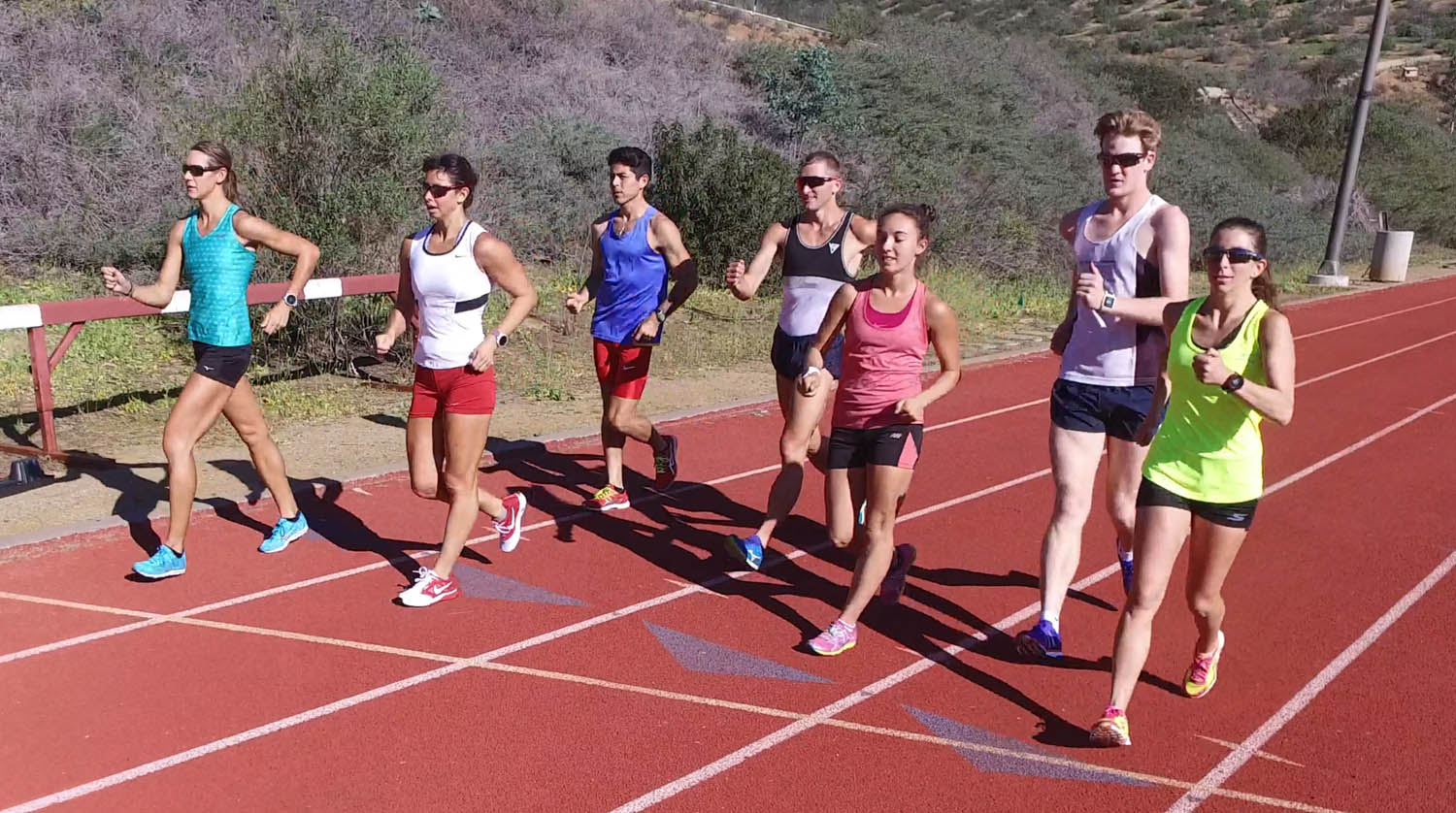
Let's start by looking at a video of relaxed technique in California where a lot of people are training to make the Olympic team. It shows everyone exhibiting smooth, legal race walking technique.
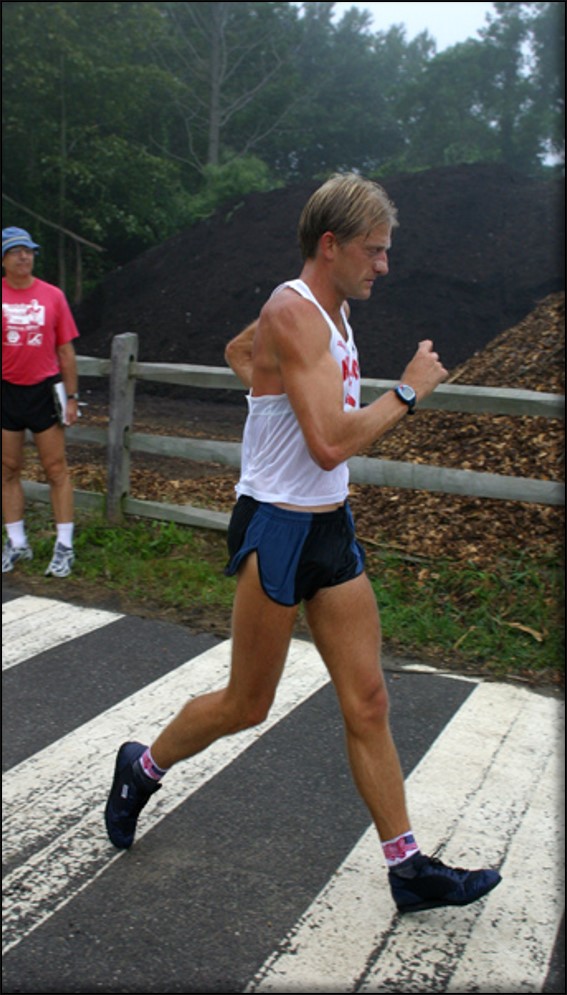
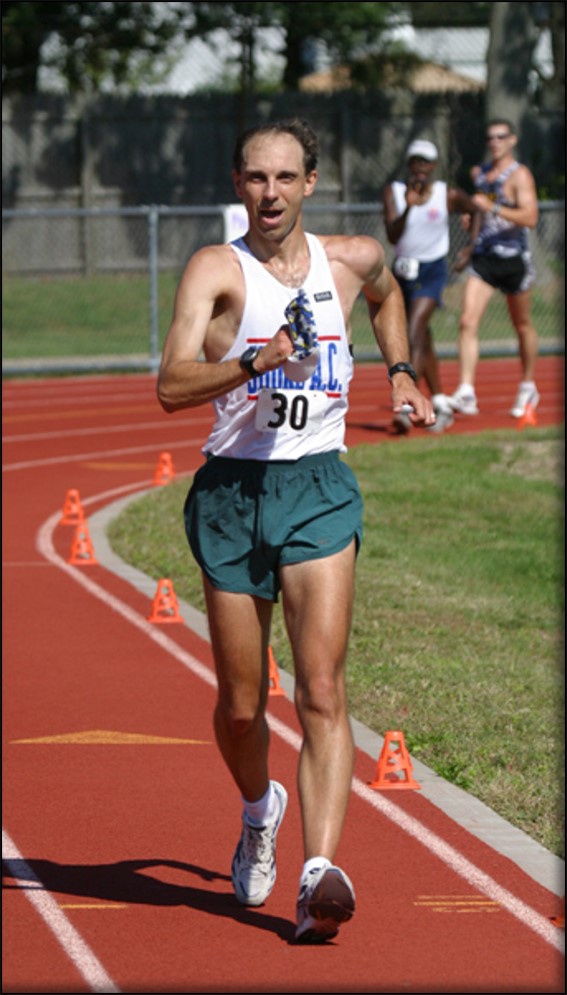
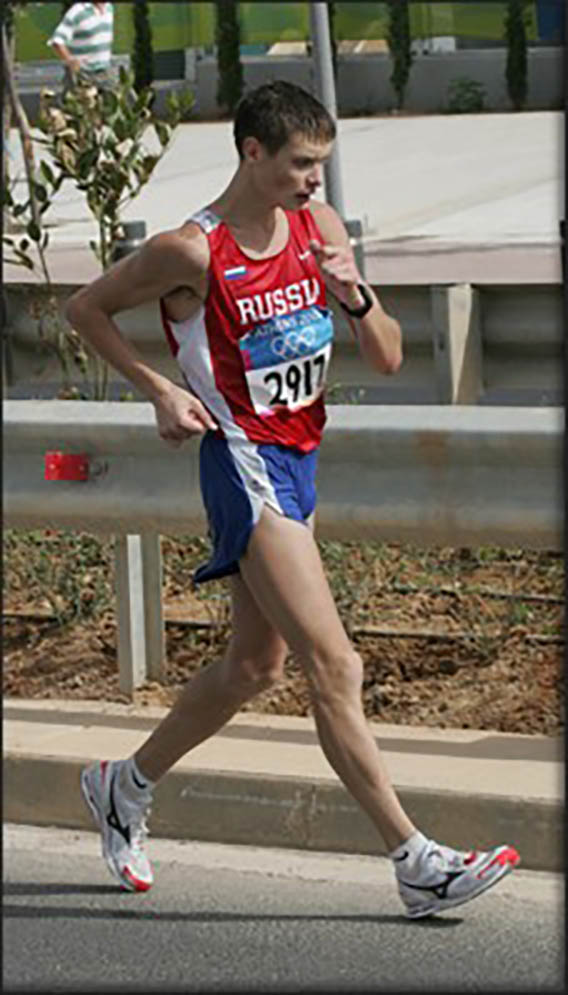
When you are judging walking you're going to see lots of different styles and different levels of loss of contact. These three pictures took looking through 50 to 100 thousand photos that I had taken of elite walkers and I'm not exaggerating because I took 15,000 photos of just race walking just at two races at the World Championships this year. These three photos were the only ones that demonstrated a visible or a momentary double support phase. You wouldn't even see this to the human eye, but the camera picked up that there was a moment where both feet were in contact with the ground. These photos exist, because there's a story behind each of these pictures. This is not normal behavior for elite race walkers. Almost every elite race walker has a moment where both feet are off the ground.
As a side bar, Gary Westerfield remembers, "Jeff was taking pictures at the World Championships in Berlin in 2009. I was judging there and I said, 'Jeff it would be nice to have some pictures showing race walkers who were point to point, heel and toe making contact.' Jeff had none and he must have taken thousands of pictures. Not a single one showed this. It just doesn't happen unless you're breaking down at the end of the race or something like that which is pretty much what was happening in a lot of these cases."
Let's get back to the analysis. In these three photos, the walkers have no loss of contact, so they are obviously legal from that perspective. Both feet are in contact with the ground for a moment. This is not ideal for an elite race walker, because the rule says "to the human eye" which means some loss of contact is allowed.
Let's look at Miranda, where the back foot is barely off the ground and the front foot's off the ground. This occurs for just a moment. Again, we must emphasize that we're looking at a still you would never see this in the real world. This is only a single frame. Later, we'll show you some obnoxious people. Again, this is not visible to the human eye.
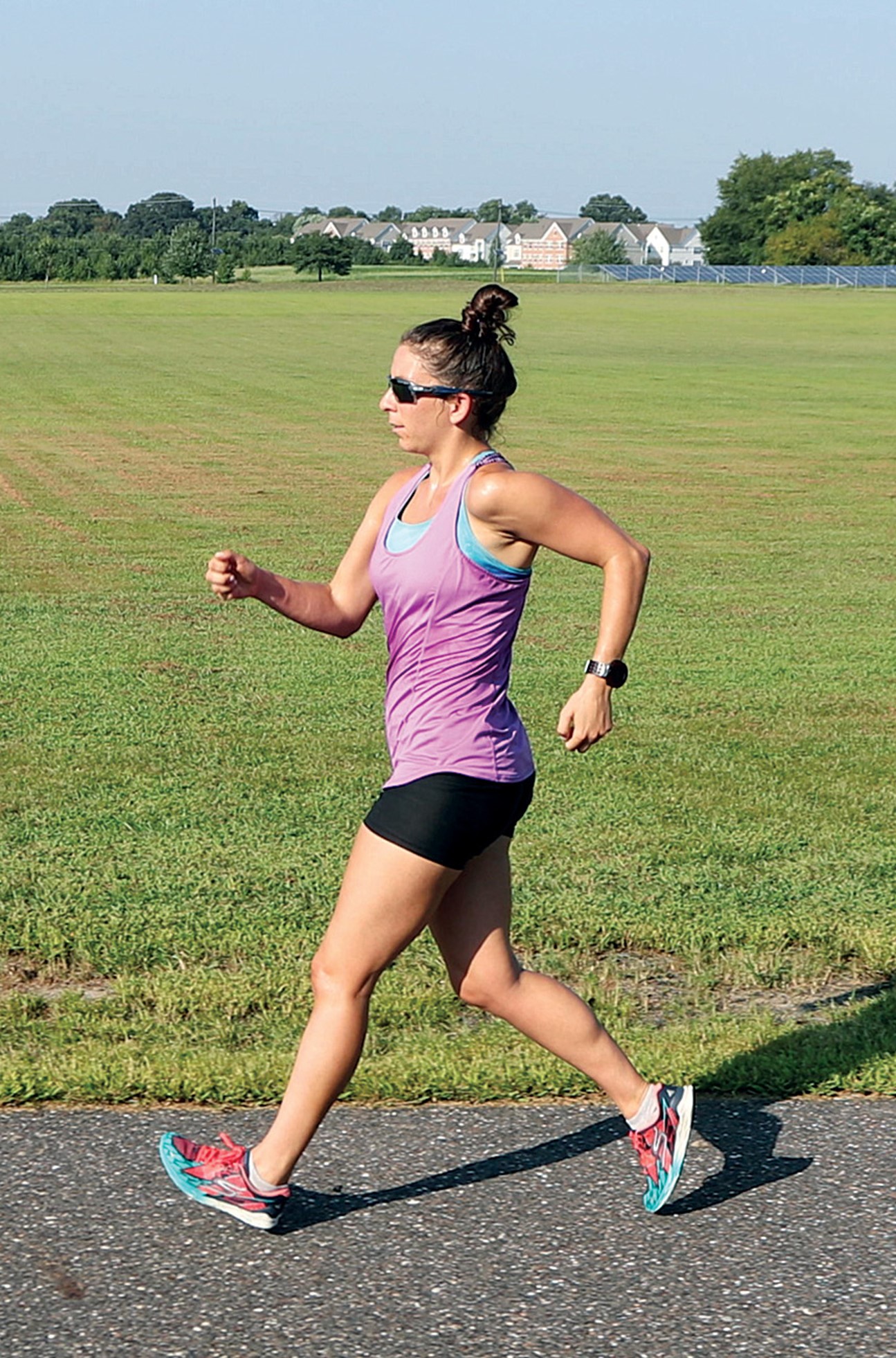
Now, she's off the ground a little more. It's still very slight by elite standards. Again, you would not recognize this with the human eye. The rule of thumb, which has been studied as recently as 2019 in a scientific setting, is that elite judges start to pick up loss of contact when its duration is 40 to 45 milliseconds. The video that's shot here was just shot with a cell phone, but a cell phone can shoot 240 frames a second. So, while she was off the ground for nine frames, which may seem like a lot, and to someone that is old school it may be, that's less than than 40 milliseconds. That's a very short amount of time. Try clicking a stopwatch and getting only four hundredths of a second. You can't do it. It's that small of an amount of time. Race walkers can be off the ground this much and still be considered legal.
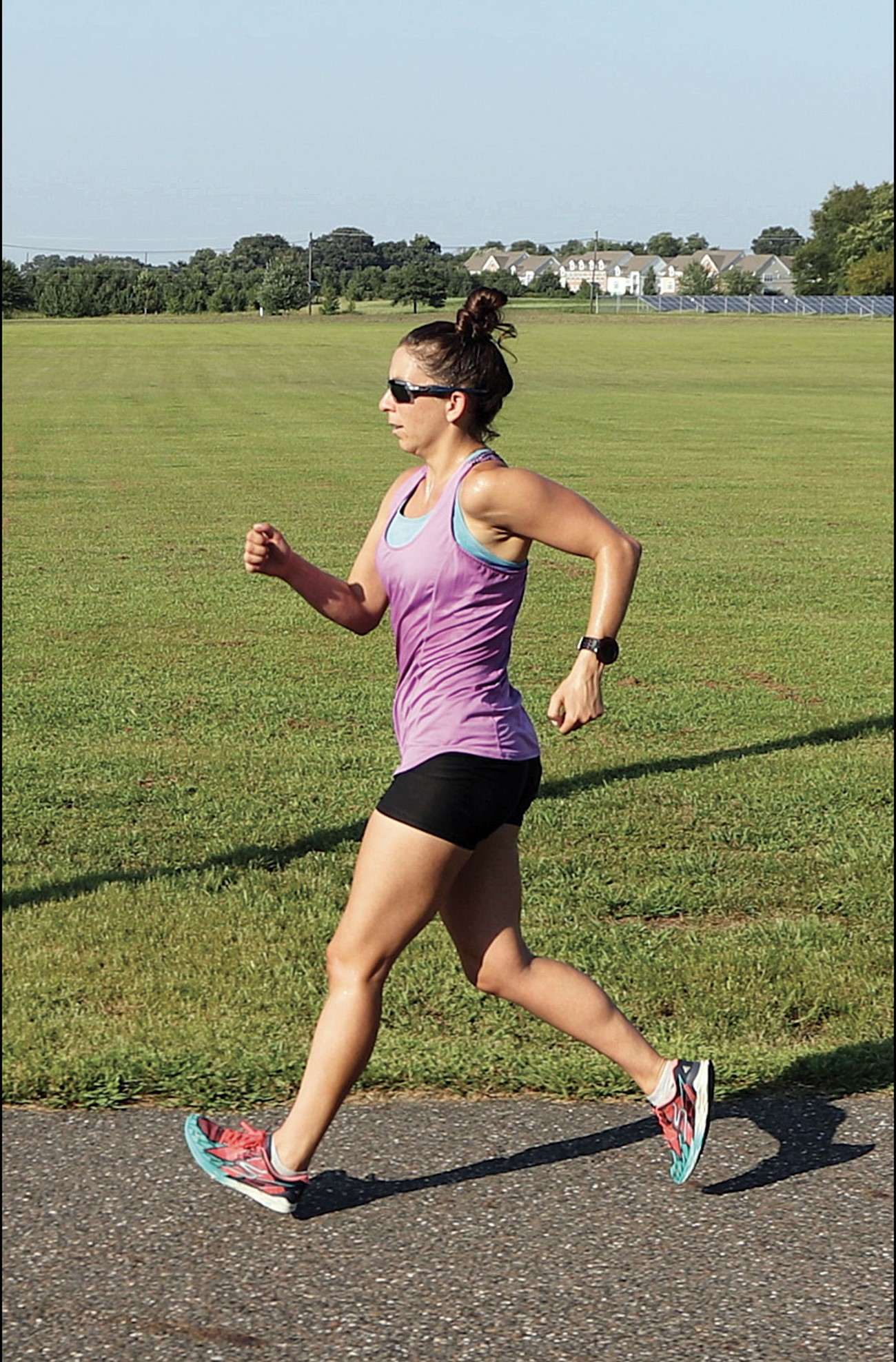
In contrast, this is somebody who actually was disqualified. What's frightening is this is much less severe than athletes in more recent races that weren't disqualified. In this case, the walker decided to take the lead at the World Championships and got a whole bunch of red cards all at once. He flew off the ground and you know one of the things about being a credentialed photographer, which I often am at these events, is I can set myself up and take pictures as if I were a judge since I know the judging and I know the the photography. He would have come into to the field of view and certainly certainly have been very questionable. When I'm filming I can't always tell live if they were illegal or not, because I am focusing on the capture. It's always a matter of judgment.
Beginning race walkers typically don't lift so you'll only see this with more advanced walkers. Just because someone is at 45ms loss of contact, it also doesn't mean they will automatically be detectable as having visible loss of contact to the human eye. So, if we had to be safe, we could say that if you were over 50 milliseconds you're probably illegal.
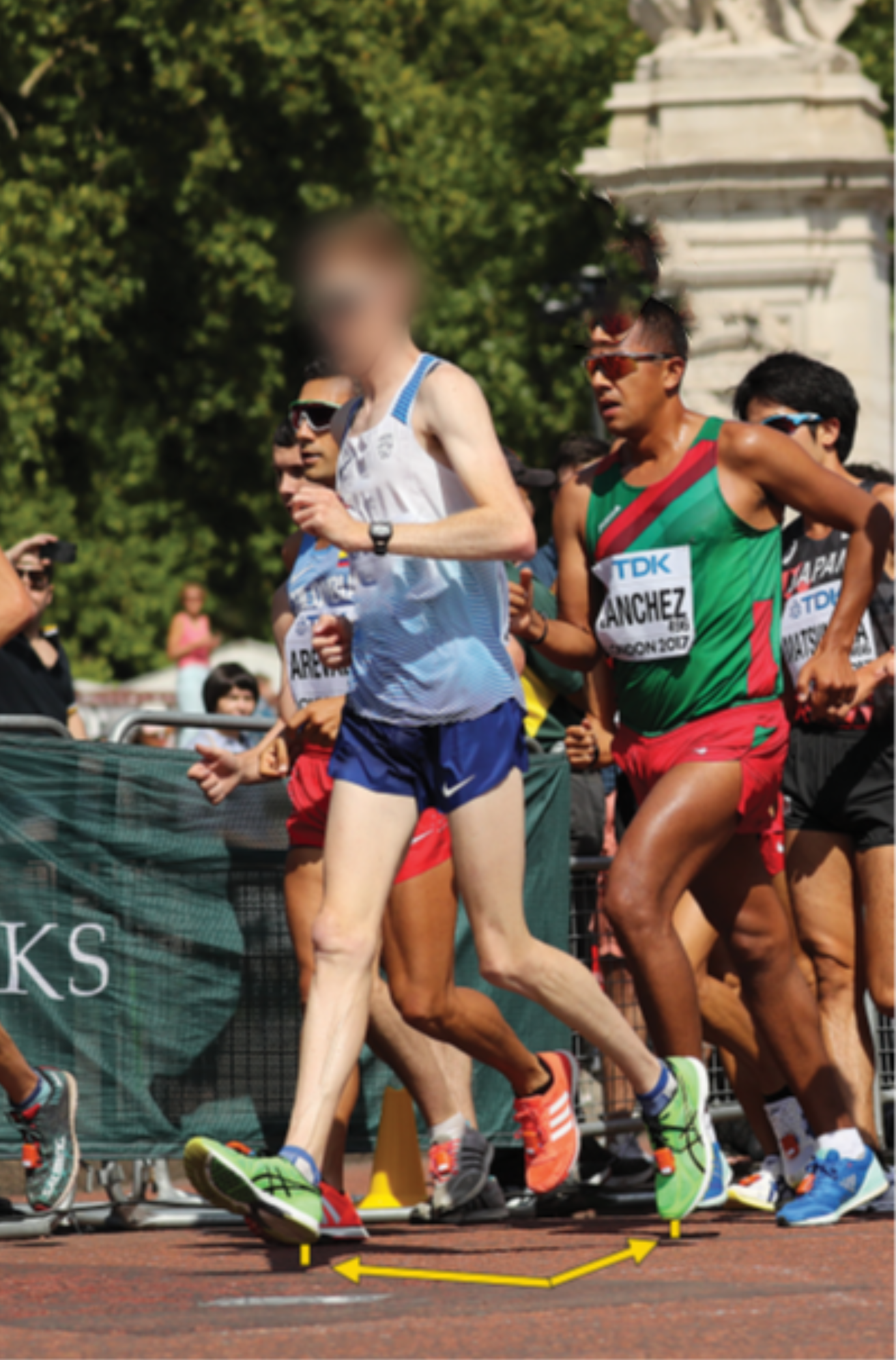
We can be too legal. This is someone who has an excessive double support phase. It's not a moment of double support, but many moments of double support and that's going to be basically what we say is visible contact. We don't need to do this, nor should you aspire to walk with this technique. However, as an official you will see this often with beginning race walkers. Beginning race walkers instead typically struggle with the straightened knee part of the definition, not the loss of contact part. What types of calls you make often depends on the skill level of the race walkers.
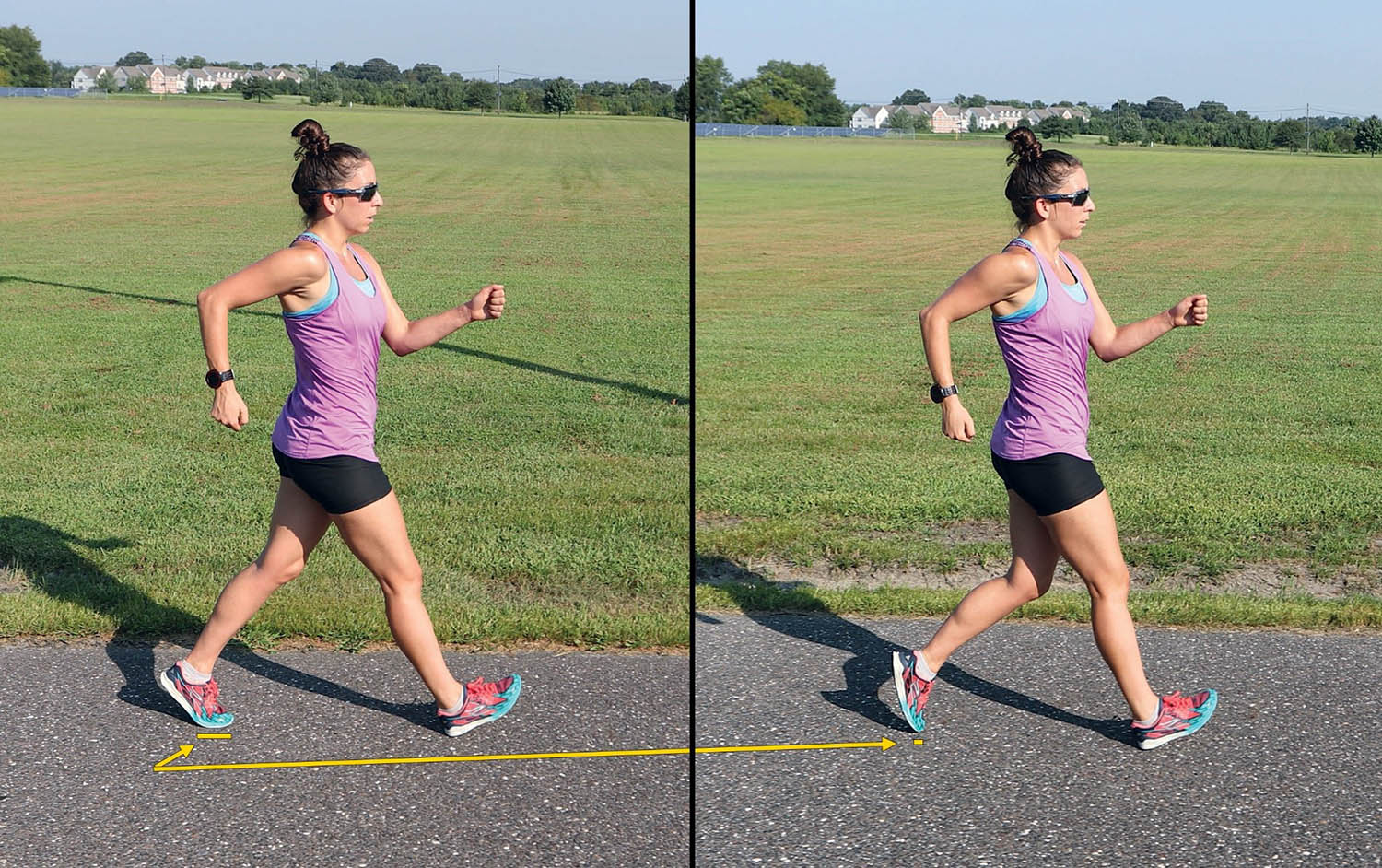
Now we're going to look at the difference between visible contact and someone with a momentary contact in motion. This is shown in real speed and then slower motion so you can see that both feet are on the ground at the same time with the walker on the left. With the walker on the right I can't say that with certainty that I see contact, just that I can't see visible loss of contact and that's that gray area. So, as long as you're not seeing a flight phase you don't make a call.
Now, let's look at Miranda's loss of contact in slow motion and this is super slow by today's standards. We can see the flight phase, but if we were just watching it at full speed, you couldn't see that. It just goes to show you that there is a flight phase at full speed that you don't see unless it is over at least 40 and maybe 50 milliseconds. For those of you who are real beginners at this, when we say loss of contact we mean you'll see the back foot leave the ground before the front foot reaches the ground. That's what we call a flight phase. This demonstration is just under the 40 millisecond threshold.
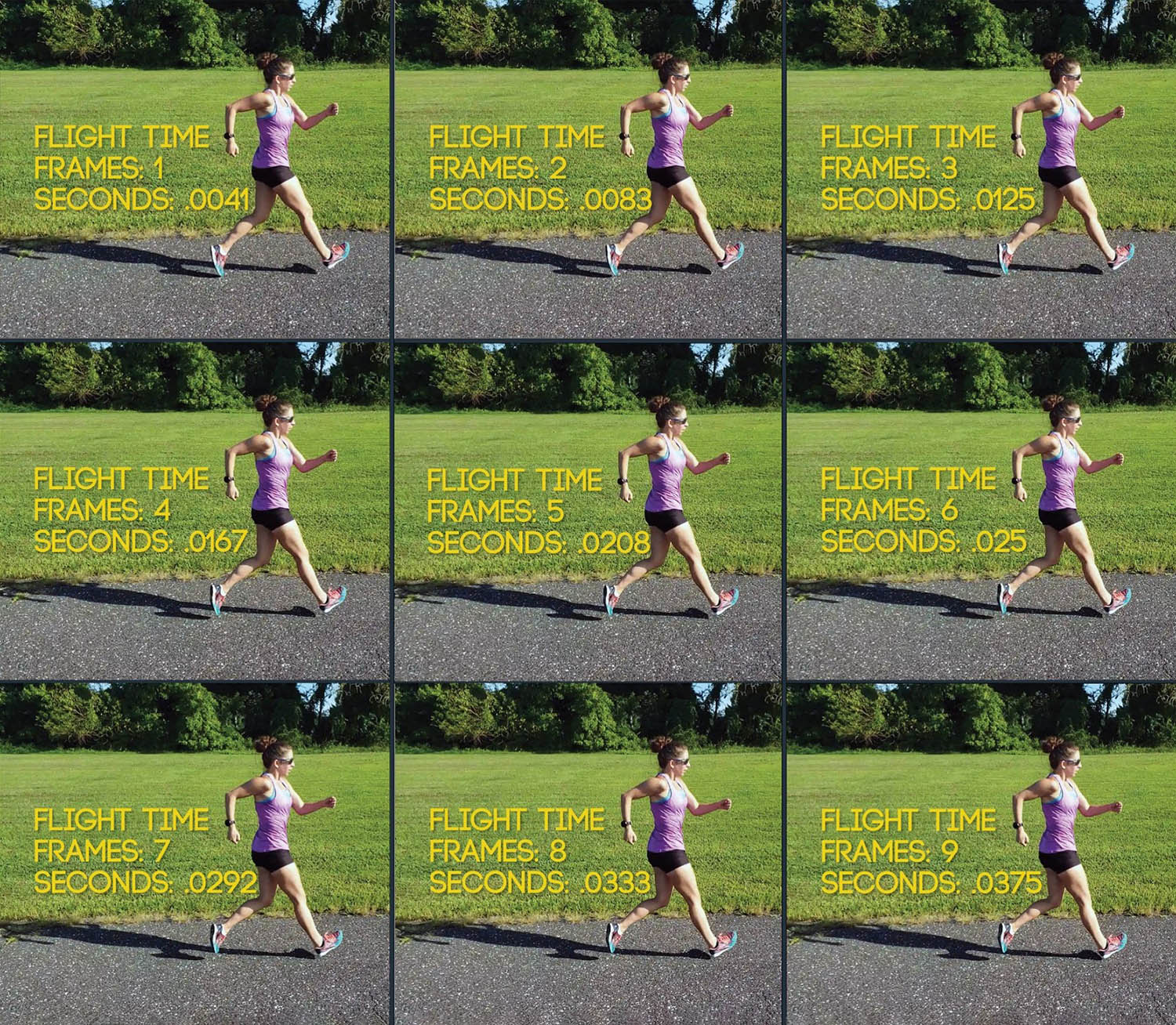
We can see a comparison at full-speed and I will actually say that Miranda isn't that bad, even in the worst case. This was the most Miranda could get off the ground. If we look at some footage from the World Championships we would see much worse than this. When looking at the first two clips, you can't see loss of contact, you can only detect it in the third. When you slow them down, of course then you can see it. Compare this slight flight phase on the left two to one on the right and you can see there's a difference and when you get to elite race walkers in shorter races, you would see even more of a difference.
So, now we're starting to see race walkers with a lot more flight under their feet. Both feet are are off the ground for a significant amount of time. When we analyze this, basically we measure the amount of loss of contact of the rear foot and add that to the amount of loss of contact of the front foot. We come up with a total loss of contact for a walker. In this case, if you were at the race, you probably could see a visible loss of contact with the human eye.
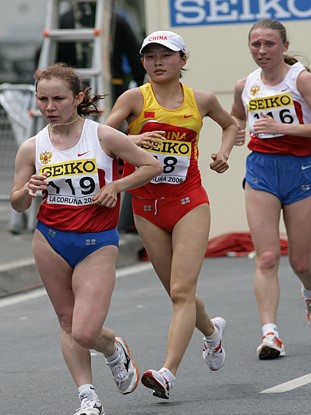
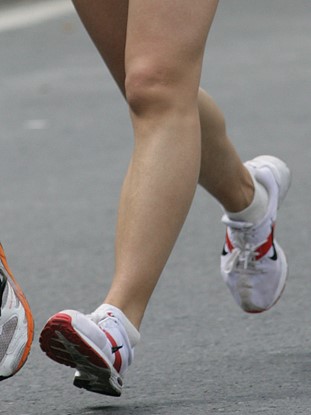
Then we got to a race this was last year and walker #16 was actually off the ground a hair more than the walker #22. However, they walked with very different styles. So, the question is can you just objectively say that oh someone's off 40 milliseconds or 45 milliseconds or even 50 and therefore they are illegal?
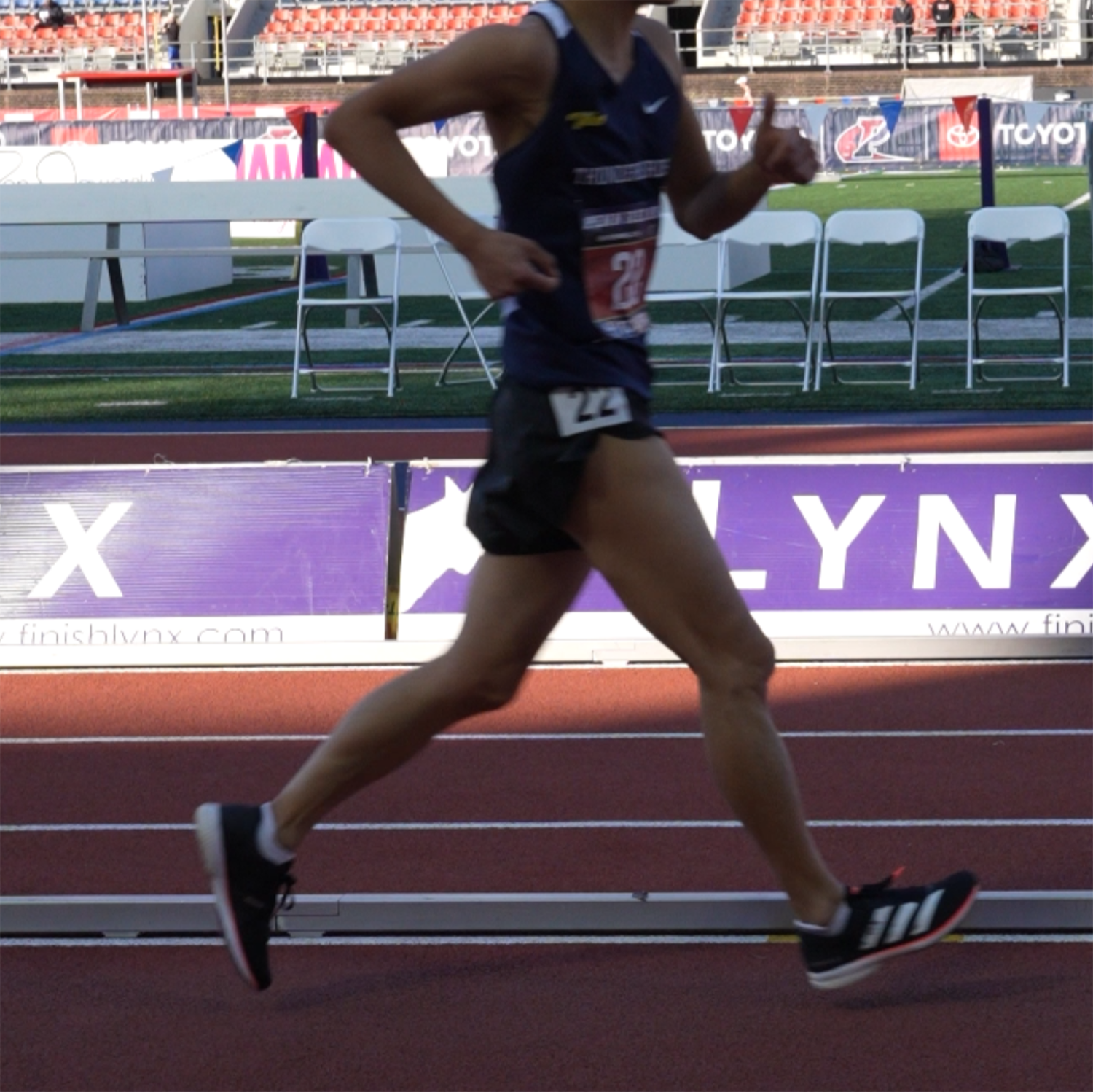
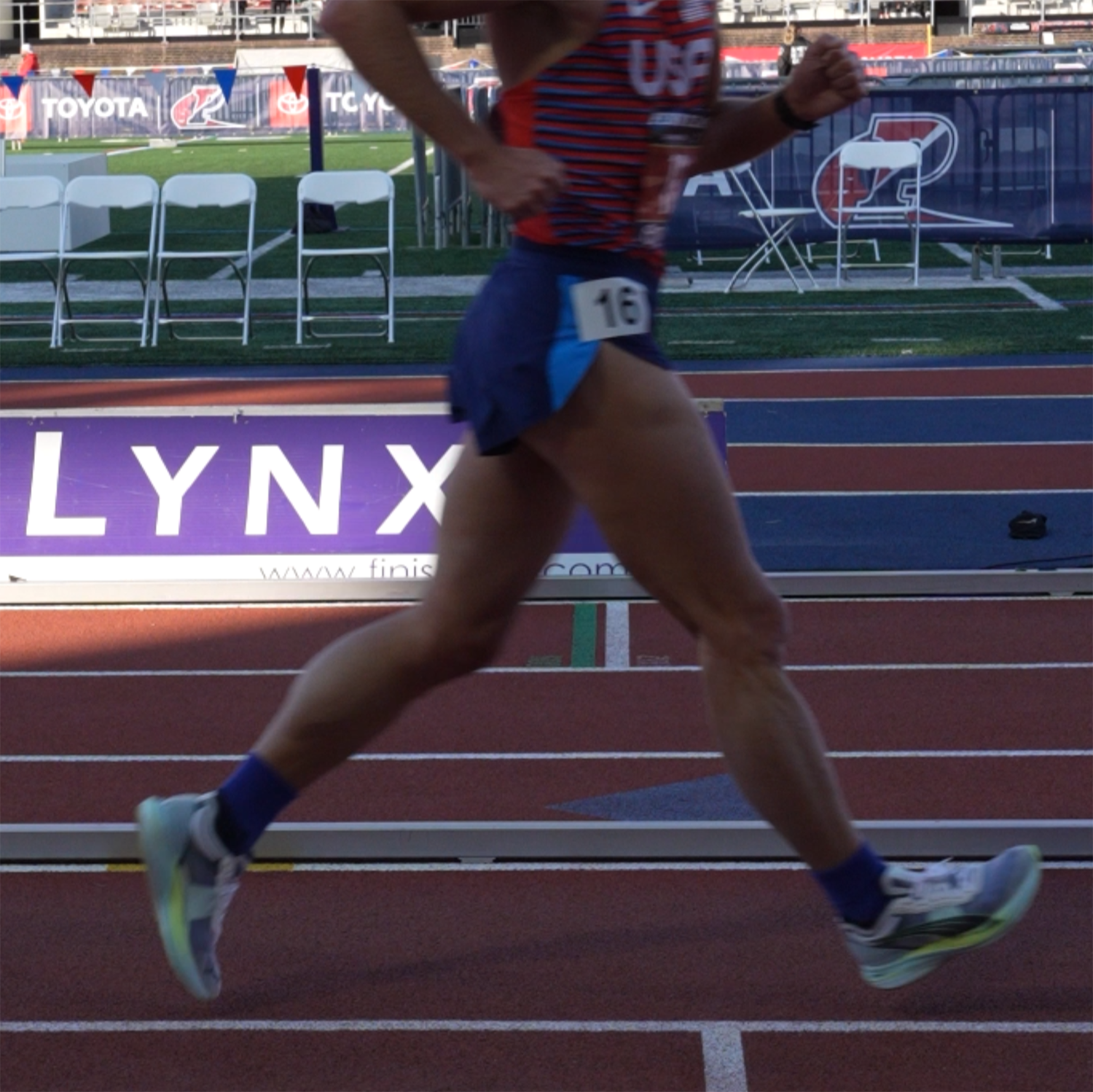
The answer is no, because the rule is to the human eye. The only real question is, do you see the rear foot coming off the ground before the front foot strikes the ground? If you don't, you don't make the call. So, we're going to look at these two and we're going to look at their stride one after another and I'll tell you I was judging this and left the cameras running in the background. I don't look at the camera while it's running. The person on the top looked absolutely awful and got peppered with red cards as well as yellow paddles. They got disqualified.


The person on the bottom looked picture perfect to the human eye. They were walking two minutes faster for a 5K and didn't get a call. I thought for sure that the person on the bottom would only be off the ground for as little as 30 milliseconds and if memory serves to be correct it was it was just north of 50.
We'll see why they were judged differently. This is the second part of their stride and you know if you're not looking closely you won't see what the difference is. We highlight it for you. Here are the two walkers. Walker #22 is obviously demonstrating a loss of contact with the ground. Compared to Walker #16, their foot is higher off the ground. Their leg is coming up close to parallel to the ground. Walker #16 is very intentionally keeping his foot lower to the ground and so even though Walker #16 had as much or more of a flight phase we couldn't see it because the foot was so much lower to the ground. So, we have to keep in mind that we are only looking to see is there visible loss of contact. If you see it, you make the call. Unfortunately, if someone does not have the beauty pageant walk and does not look as good, it may highlight their loss of contact more than somebody actually has more loss of contact.


Walker #16 was three inches off the ground. Walker #22 was six inches off the ground. Double the foot height. We weren't the first people to look at and do this kind of analysis. There was a study in Japan that basically said race walkers with a higher rear foot carriage tend to get more red cards. This makes anecdotal sense. So, if you're judging one of the things you'll pick up here is that if you think you see visible loss of contact and you see a high rear foot after push off combined with the leg almost becoming parallel to the ground you're probably justified in giving them a call.
The conclusion we take from this is we may not like to admit it but to some degree it's a beauty contest. However, notice that we are not talking about what's going on with a walker's arms or what's going on with their head. Too often we hear, I see your hair bobbing up and down. This is not the beauty contest that we are talking about. As a judge you should not be looking at the upper body to make a call. You might look it up at the upper body when they're far away and notice that the head's bouncing. You might tell yourself, "I'm going to look at them more closely when they get they get nearby me." But when you're judging you're just looking at the feet for loss of contact and we'll talk about the knee in a second. But if their feet and legs don't look beautiful in terms of of technique, that's style and unfortunately, it may affect how we judge them.
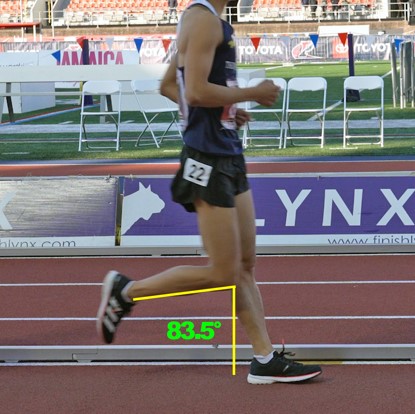
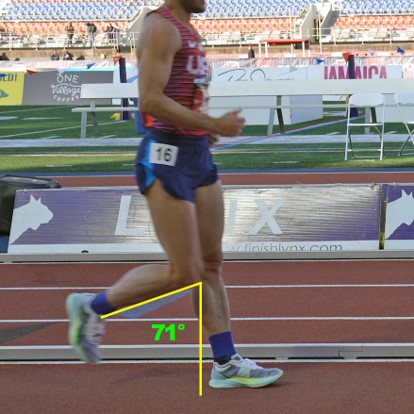
Let's move on to the second half of the definition, which is the straightening of the knee. Shown here is Jack Starr, who was my star pupil. I started coaching him at 65. He's now 94. We were recently talking about whether or not he's making a comeback for the 95 year old age bracket. He can do this and walk legally, even though he has a knobby, old knee. It straightened perfectly. If you tried walking with your legs straight all the time you're not going to get very far. So, when we say straight, we only mean for a portion of the stride and and we'll we'll show that in a second when we look at some videos. We'll see that it is difficult for beginner race walkers to master, at least some of the time, but if you're asked to judge right you've got a judge based on the rules.
There are some master race walkers that claim they can't comply. For them, there is the National Power Walking Association. However, race walking says you have to follow this definition. If you can't, you're not race walking.
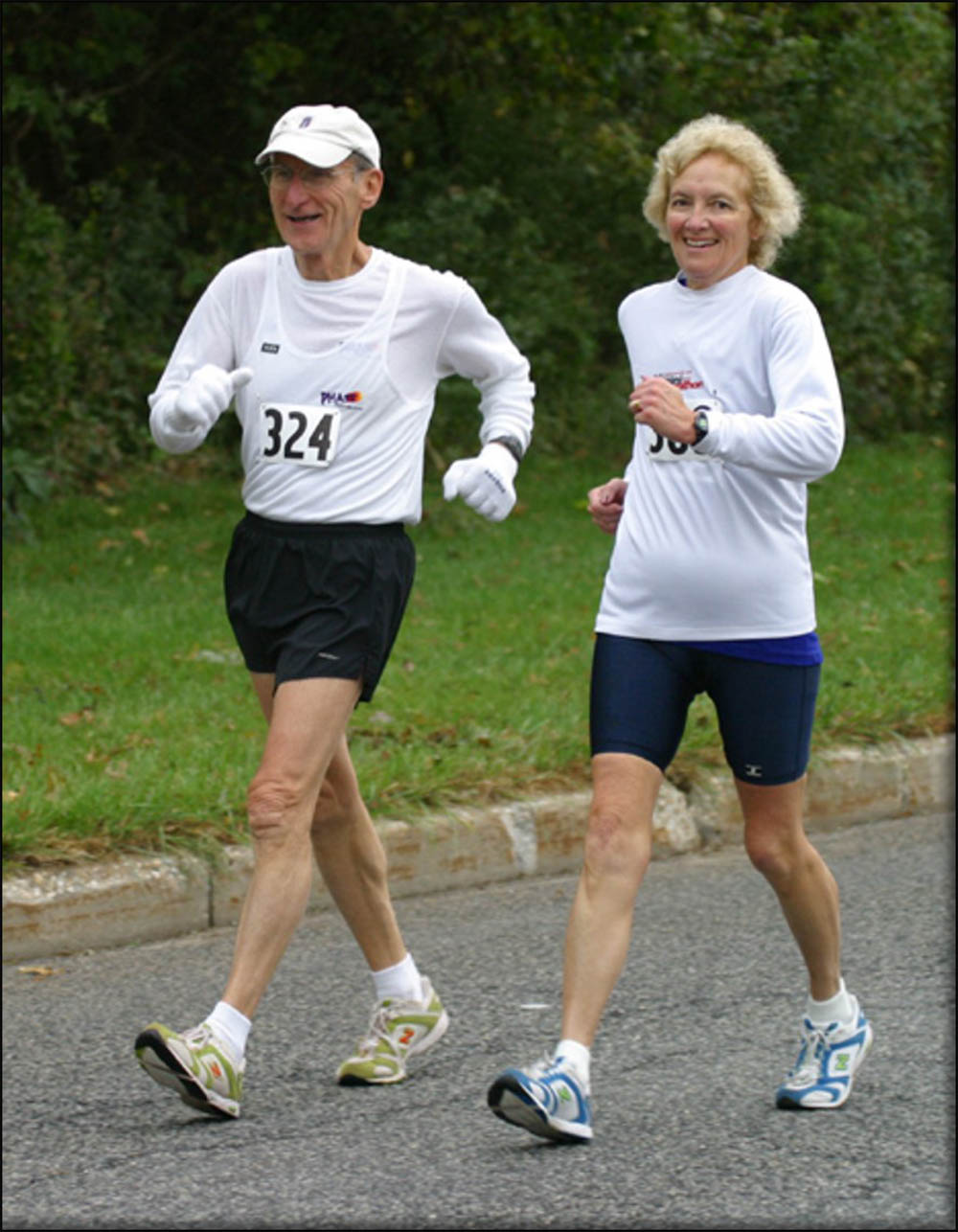
Let's look at the step while the leg is in the support phase. We see that when Miranda strikes the ground her leg is already straightened.
It stays straight into the vertical position, then as is usually the case with an elite walker, she doesn't bend her knee. Instead, she keeps it straightened past vertical. This is not required by the definition, but leads to more efficient technique.
Often, if somebody looks like they're bending their knee, and if we were coaching them, we would say keep your leg straightened longer, the elites are all doing it. If you look at Miranda the foot is breaking basically at the ball of the foot. At that point, the knee starts to bend and the leg is ready to move and and swing forward.
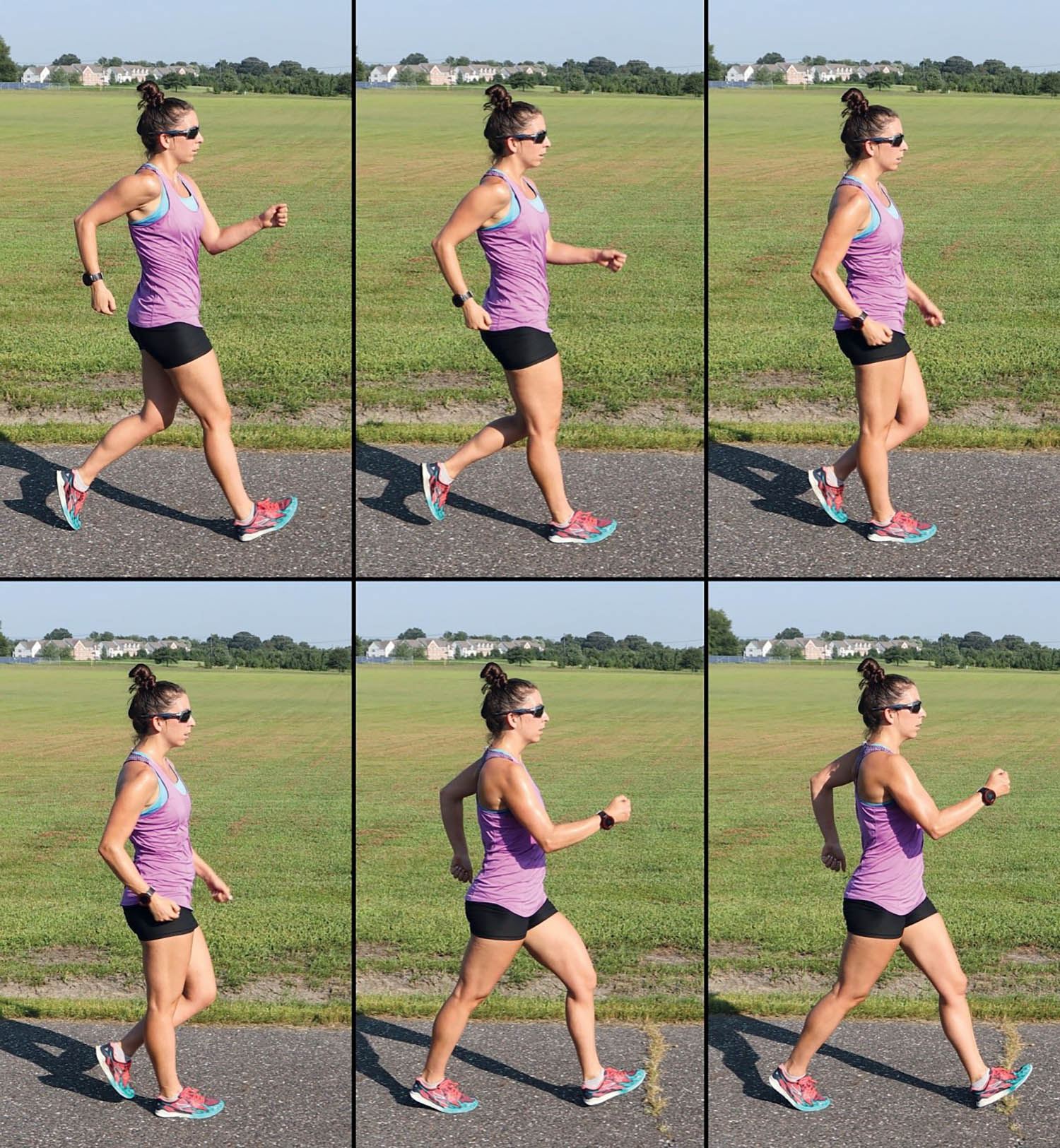
We will now look at the support leg one frame at a time. As the foot strikes the ground there is a reasonable angle below the foot in relation to the ground. Good walkers will keep their hands lower, close to the sternum and also behind the hip, but we're not judging by that. It is simply good style. Next, you see the rear foot has really rolled up onto the back toe.
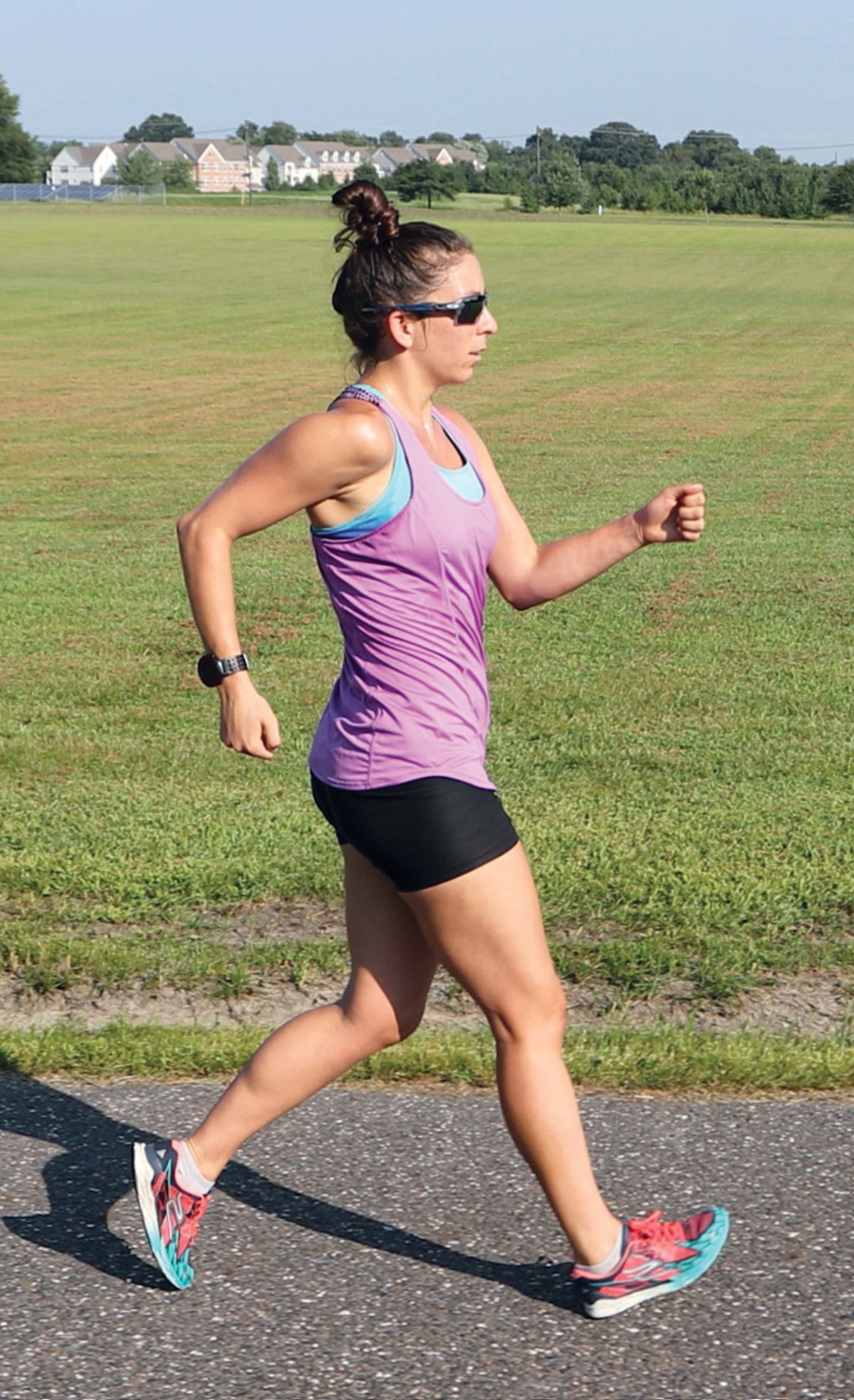
As she progresses through her stride, the foot flattens, but not all at once. The leg stays straightened as she progresses forward.
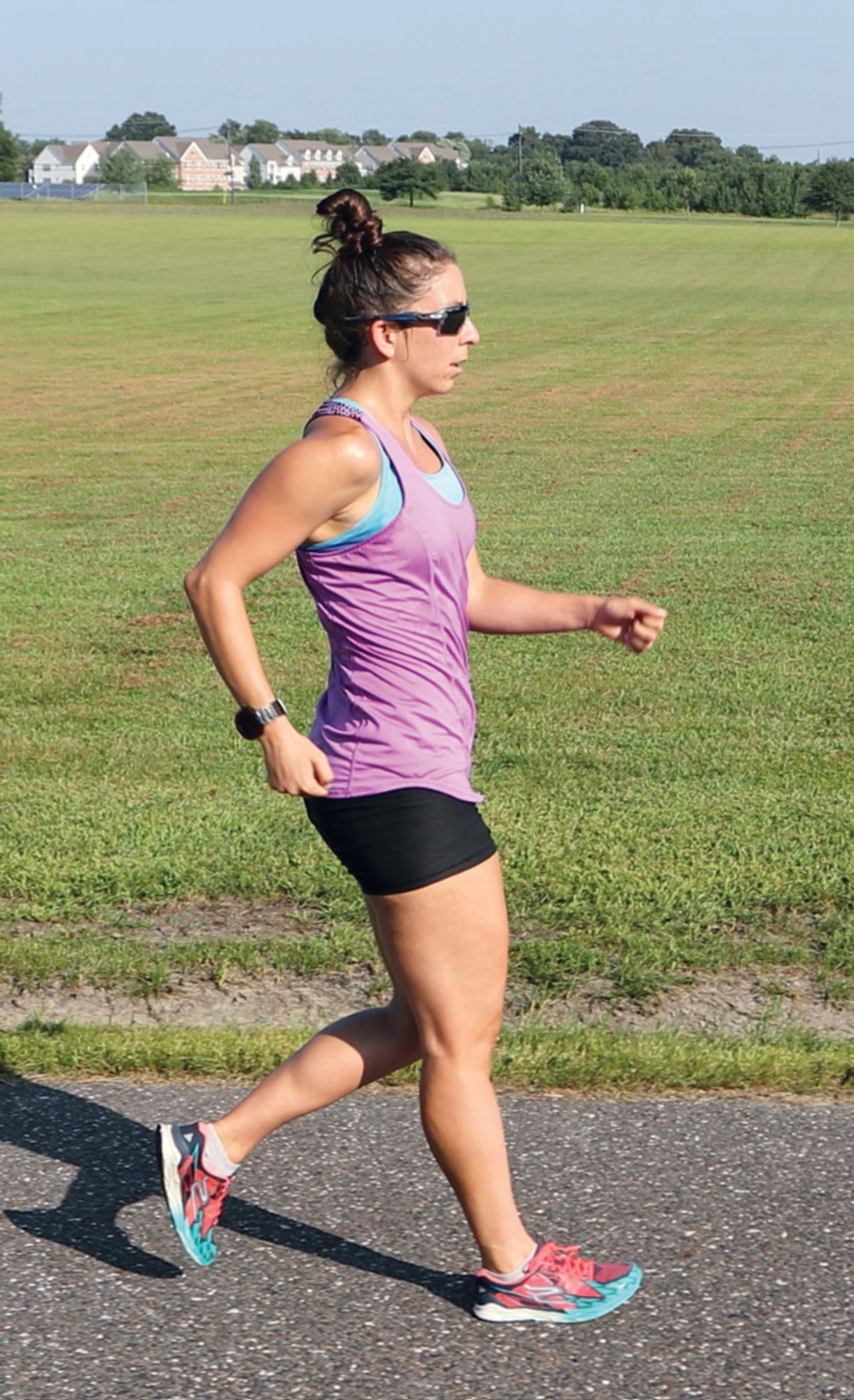
Now we're in the vertical position, this is the last point the leg must be straightened for purposes of adhering to the definition.
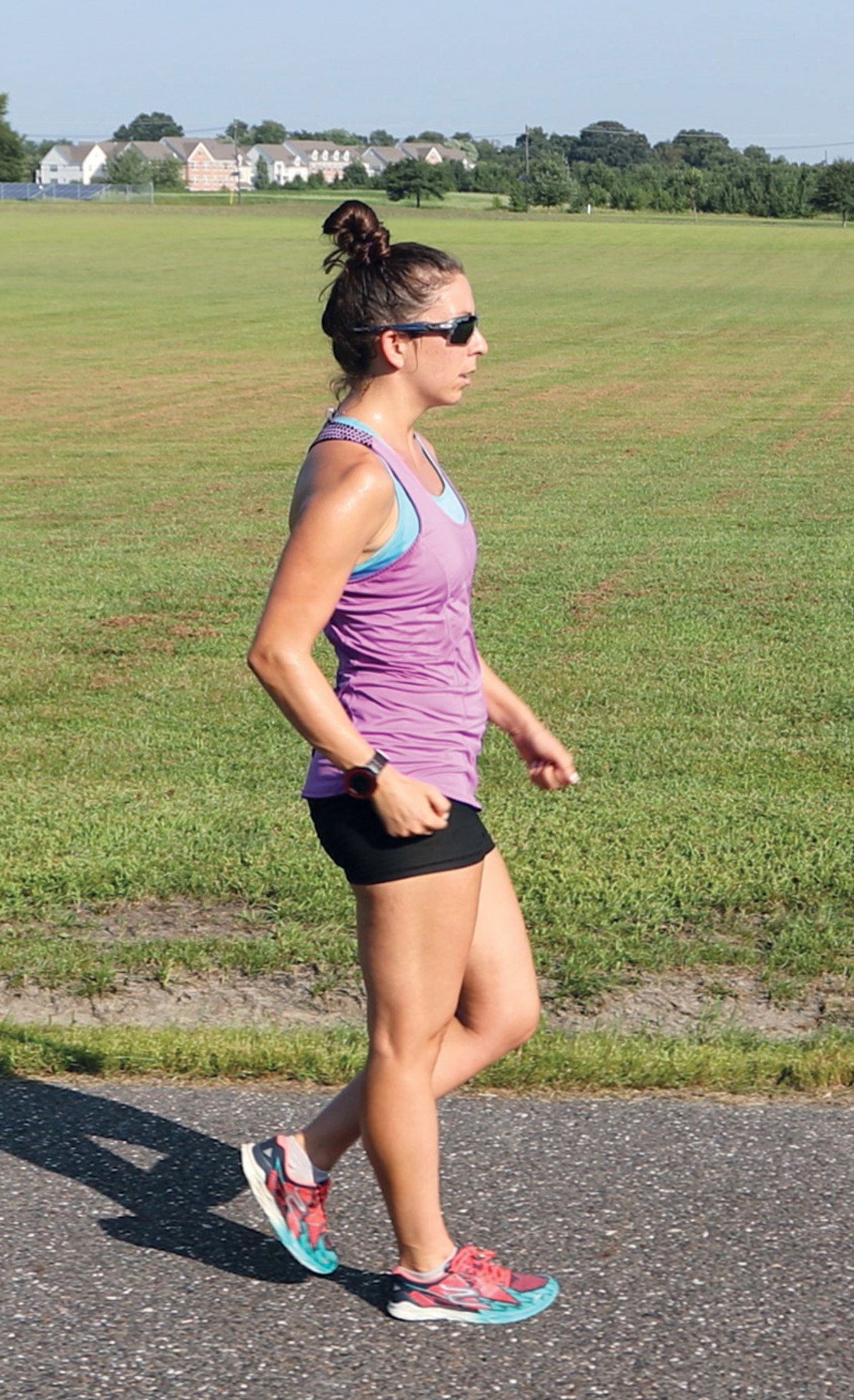
Miranda's leg stays straightened longer, because she's a very strong athletic walker.
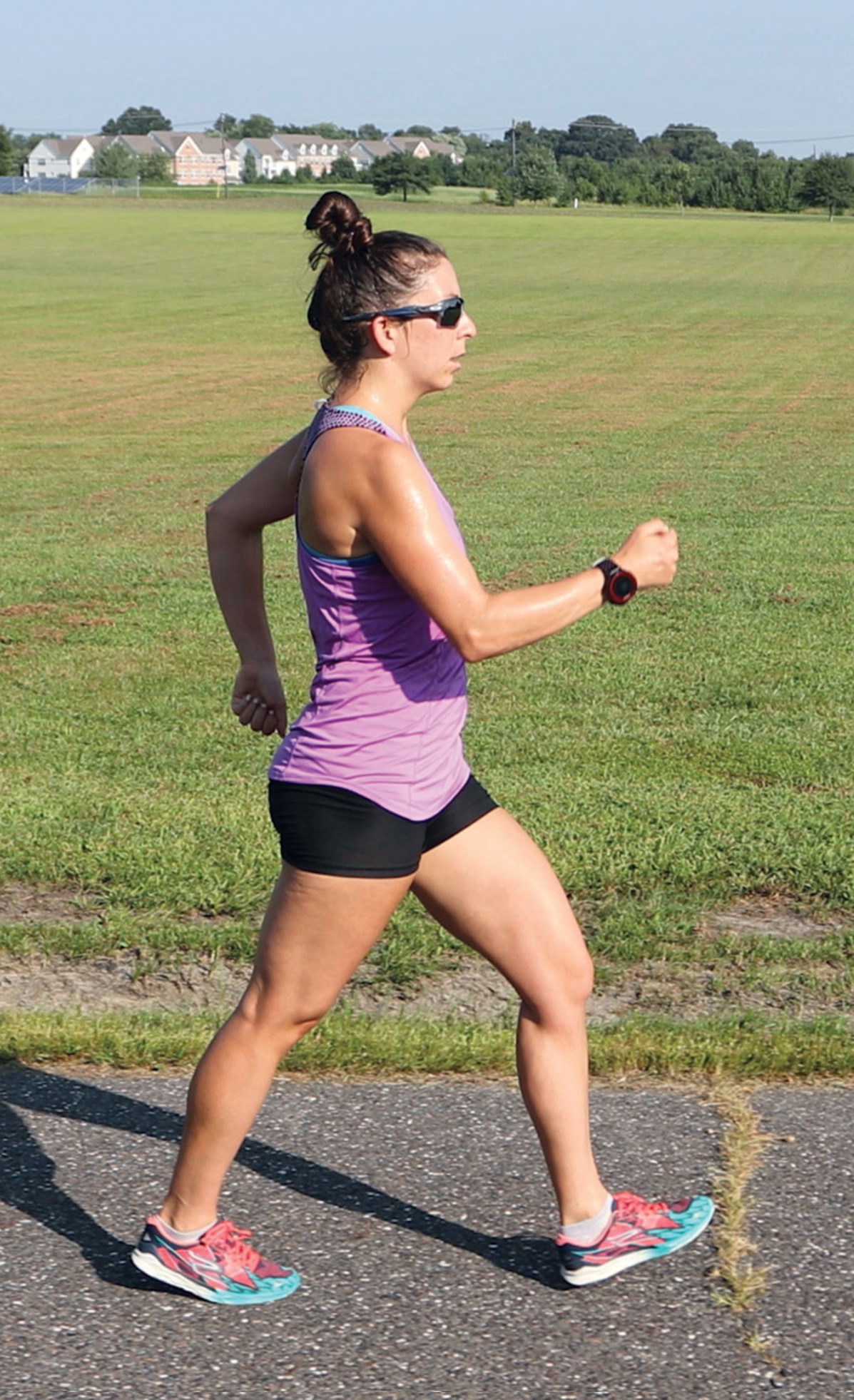
Then as she's ready to bring it forward, the knee starts to bend. This is usually when the heel is off the ground and the foot is bent.
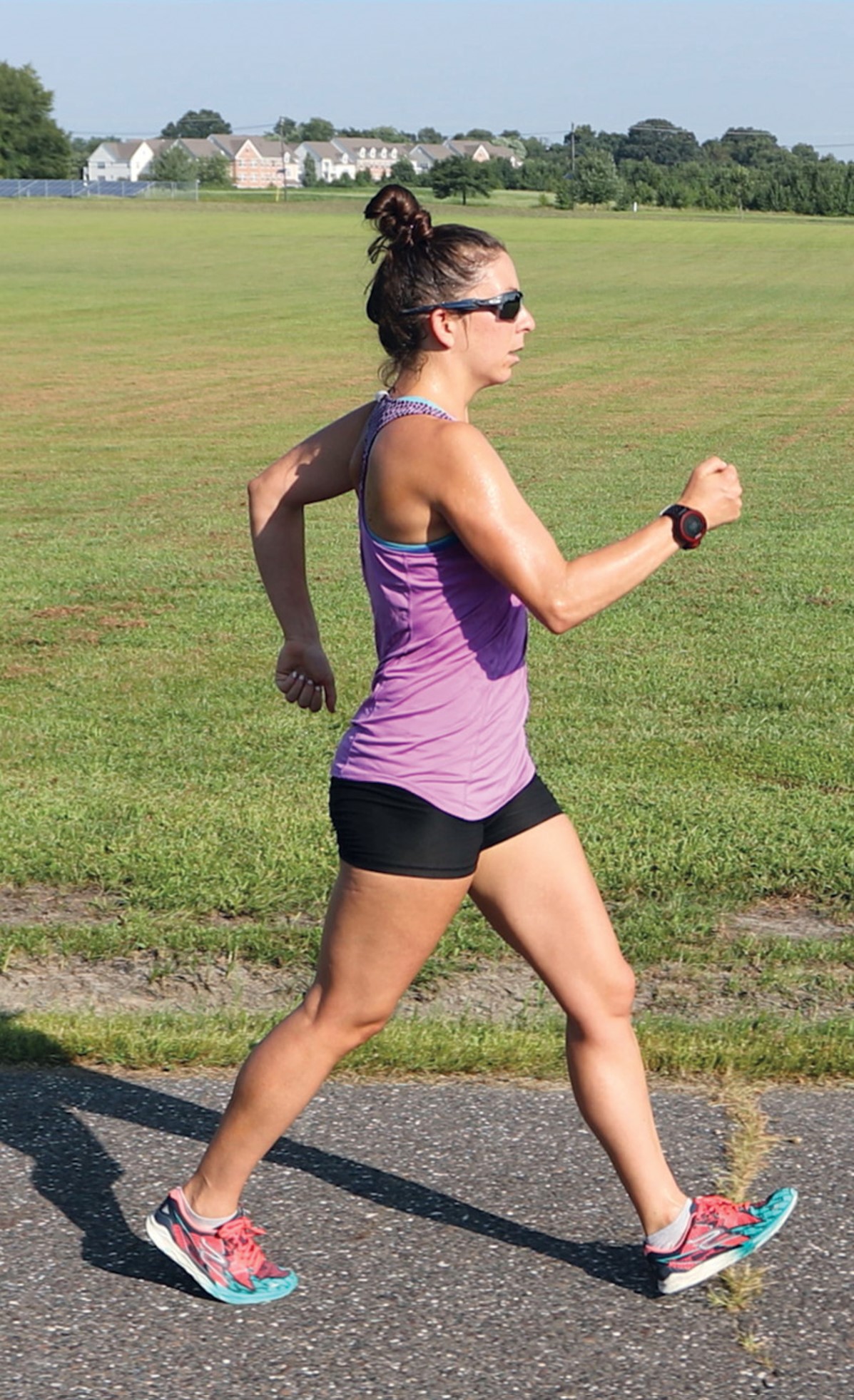
Finally, we see her bent leg as it's about to come off the ground. This of course is legal and necessary. Walking with a straightened leg all the time would be incredibly awkward.
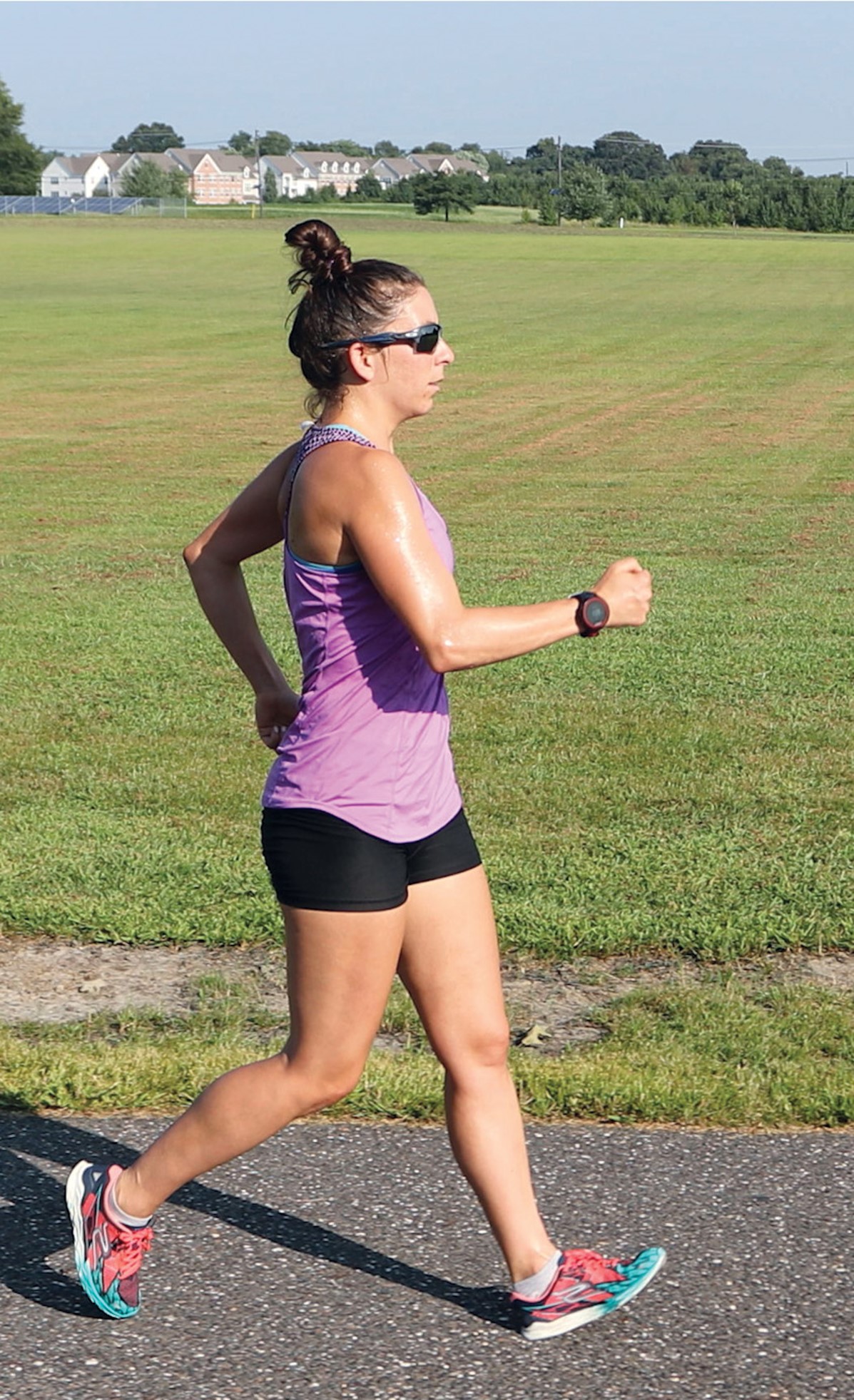
When a race walker lands bent, it's pretty visible. This walker lands with a bent knee and while they eventually straighten their knee, they are not race walking according to the definition.
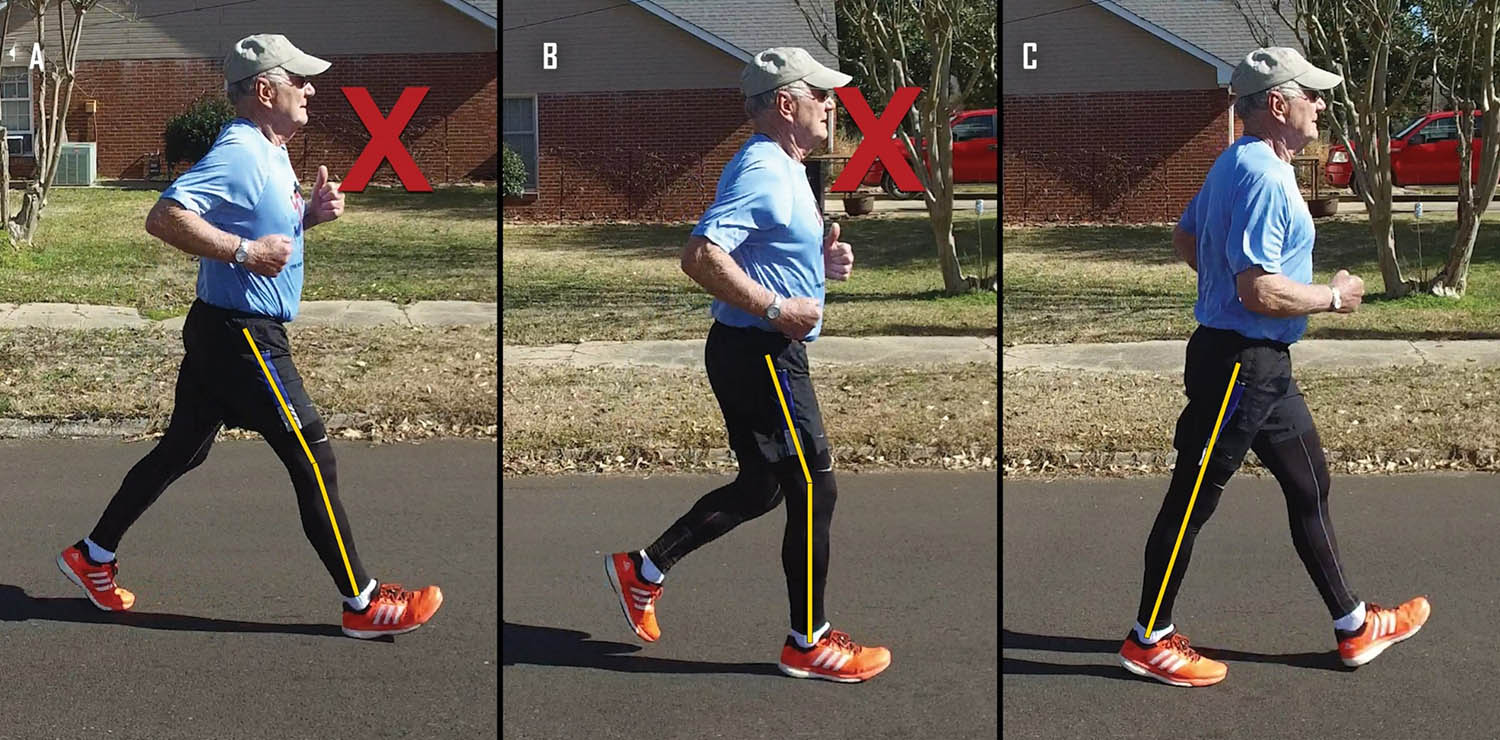
Now we see the same race walker in very slow motion. You can see them eventually straightening, but not at the right point.
Some walkers land straightened, and then bend. This is also not legal race walking.

Now, we can watch him in video. What's interesting is if we froze the video here, his leg is straightened, but his foot has not hit the ground. We'll talk more about that in a second, but once he puts his weight on the leg it flexes. He's got what we would consider a hiking motion.
It is very important to realize legs and knees come in many forms. Here, we're looking at somebody that is bow-legged and another with a knobby knee. These are not reasons to give a bent knee call. What we want to look at is the femur, fibula, and knee (upper and lower leg or thigh and shin) and ask if they form a straight line? If they line up during the right part of the stride, then they're legal. Period. Anecdotally, it seems like a lot of race walkers have bow legs. The question is does that happen because people race walk for a long time or did they become a race walker because they were bow legged and couldn't run? Also, hyper extension, which is bending the knee backward is acceptable. It's considered straightened.
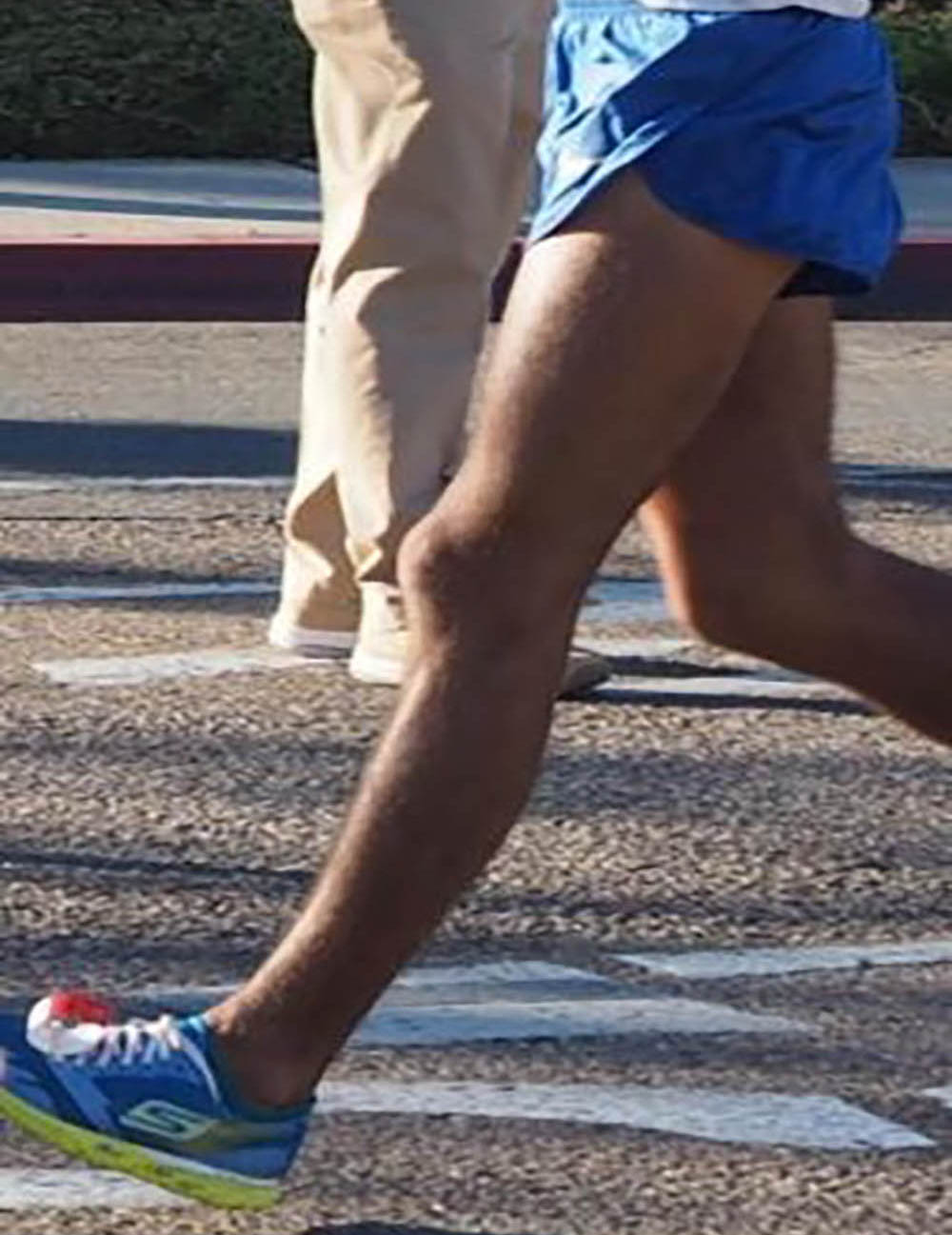
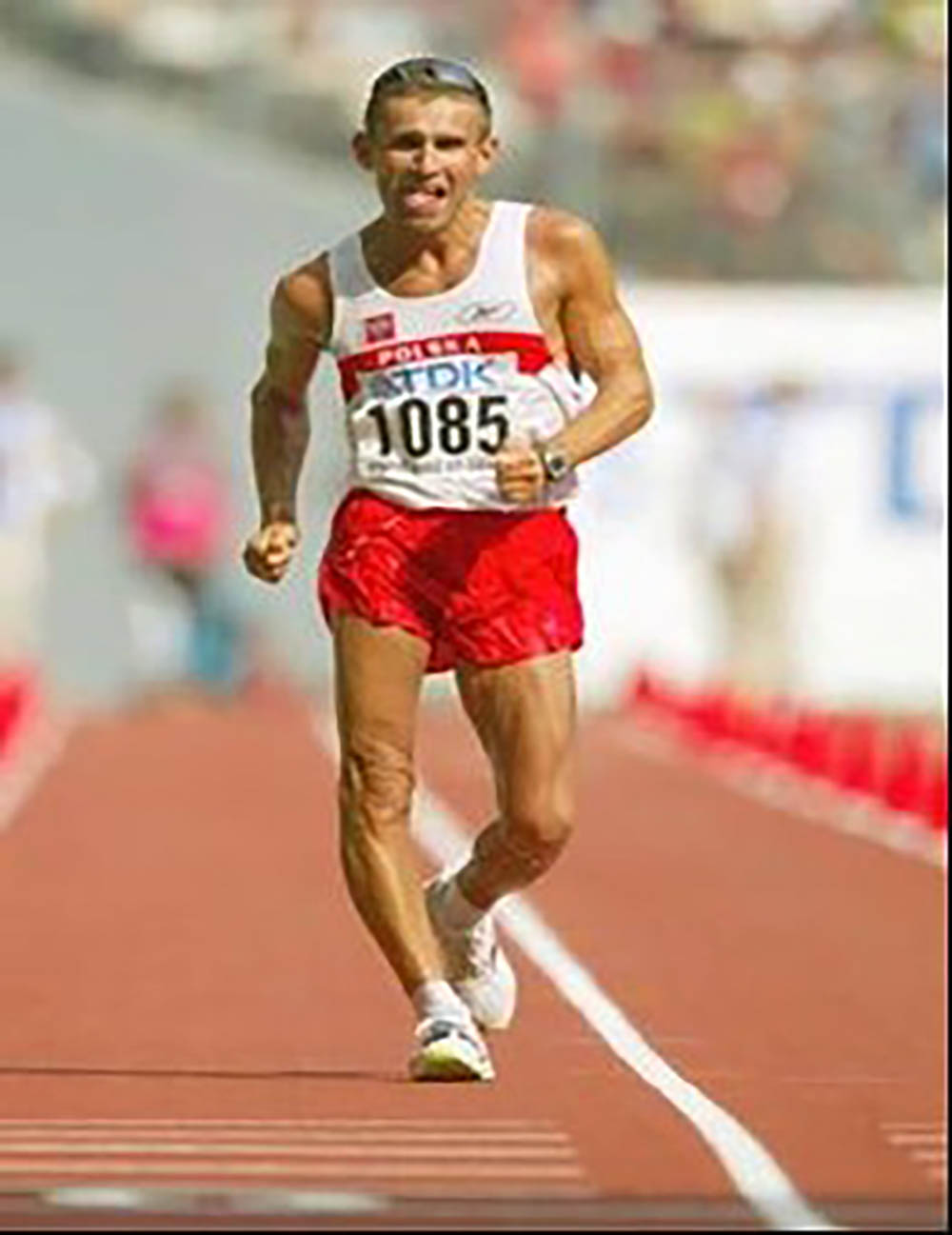
Let's watch Miranda demonstrate perfect knee straightening in slow motion. She basically is bent until the moment before she strikes the ground. Then almost simultaneously she straightens as her foot strikes the ground. As Miranda strikes the ground, there's a straight line through the knee. It stays straight in vertical and it's even straight after.
We can compare her side by side with Jeff Salvage who is walking with a bent knee. He's landing bent and staying bent. You can really see the difference between the two. Jeff never straightens his knee at all.
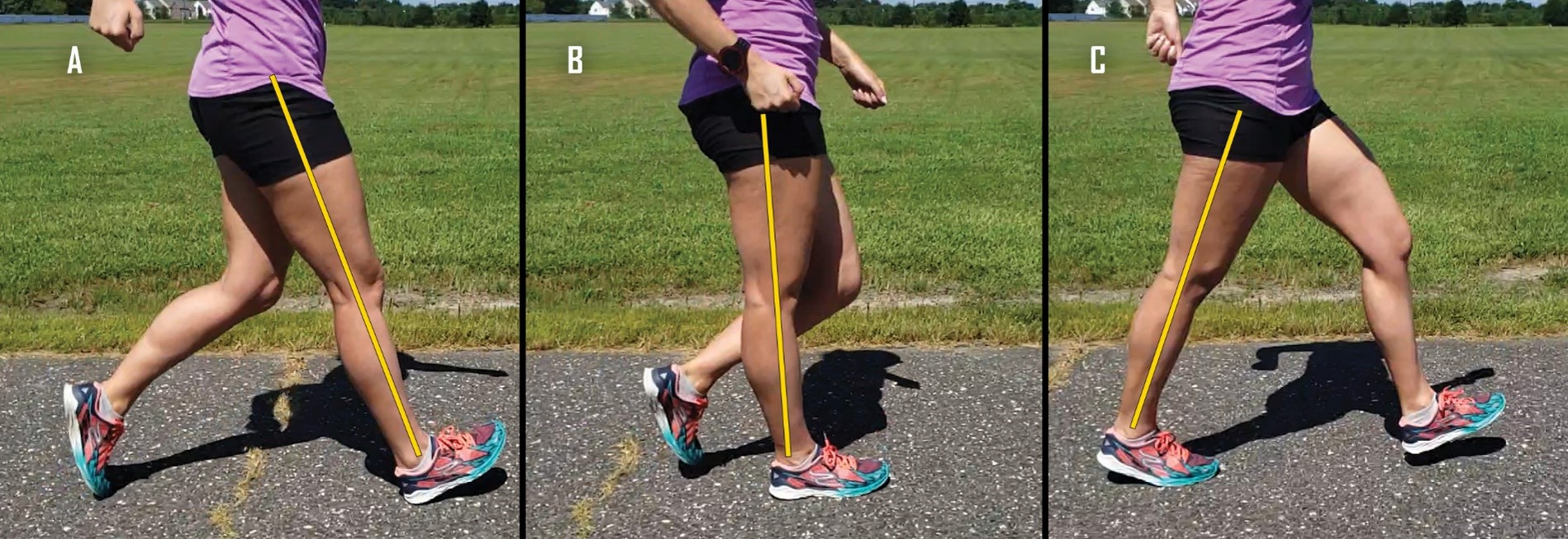
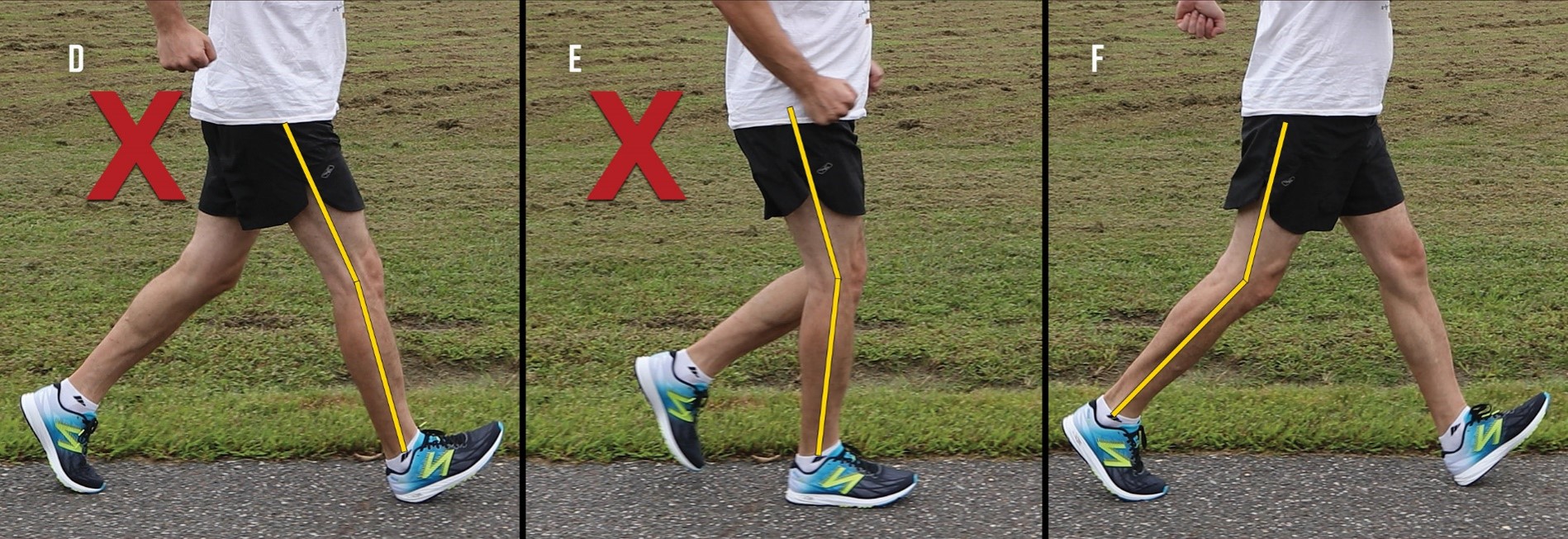
Take a quick look at Walker #7. Her knee is bent, so she's illegal, right? But her foot hasn't struck the ground yet, so you do not judge the bent knee until after heel strike. This is very very important. If you look at Walker #2, she has just struck the ground and her leg is completely straightened. It certainly looks like Walker #7 will be straightened when she strikes the ground, but she hasn't struck the ground yet. So, you have to wait till you see that contact to decide if you're making a call or not.
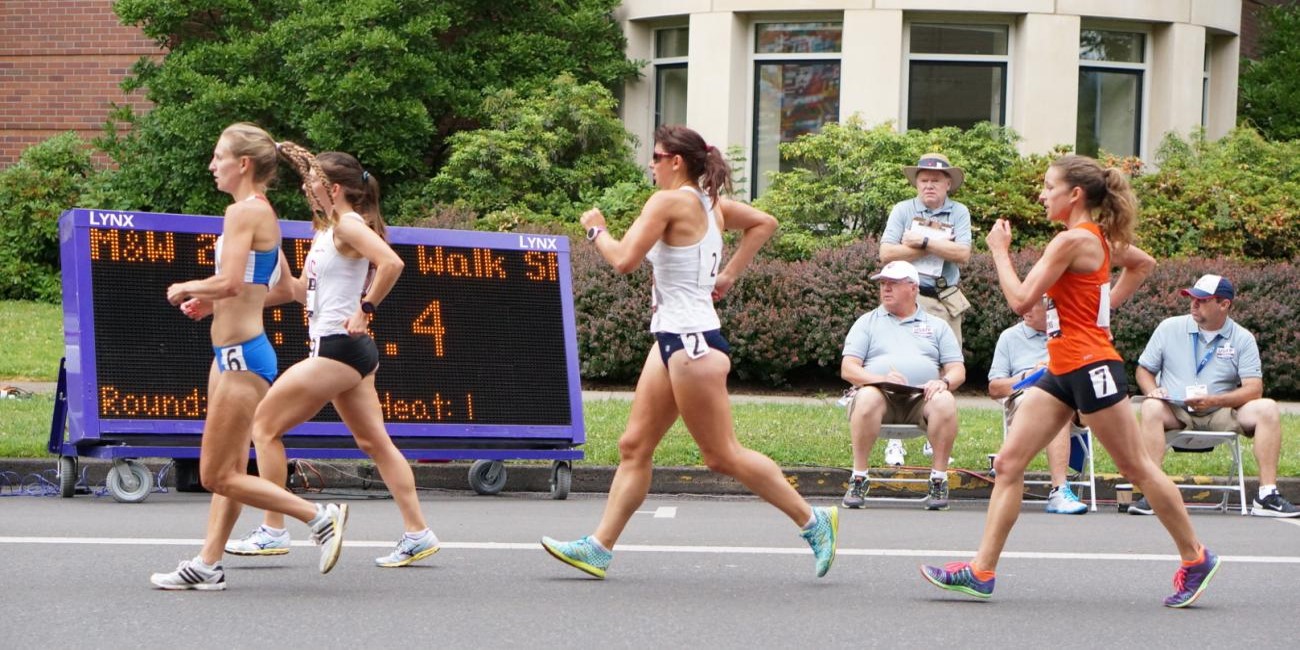
This walker is walking with a very different style than we are accustomed to. She is walking and landing with a nearly flat foot. While this is unusual and typically leads to bent kneed walking, it is not by itself a violation of technique. Again, we look at the leg and see it lands straightened and stays straightened through the vertical position. Therefore, she is not violating the bent knee portion of the definition of race walking.
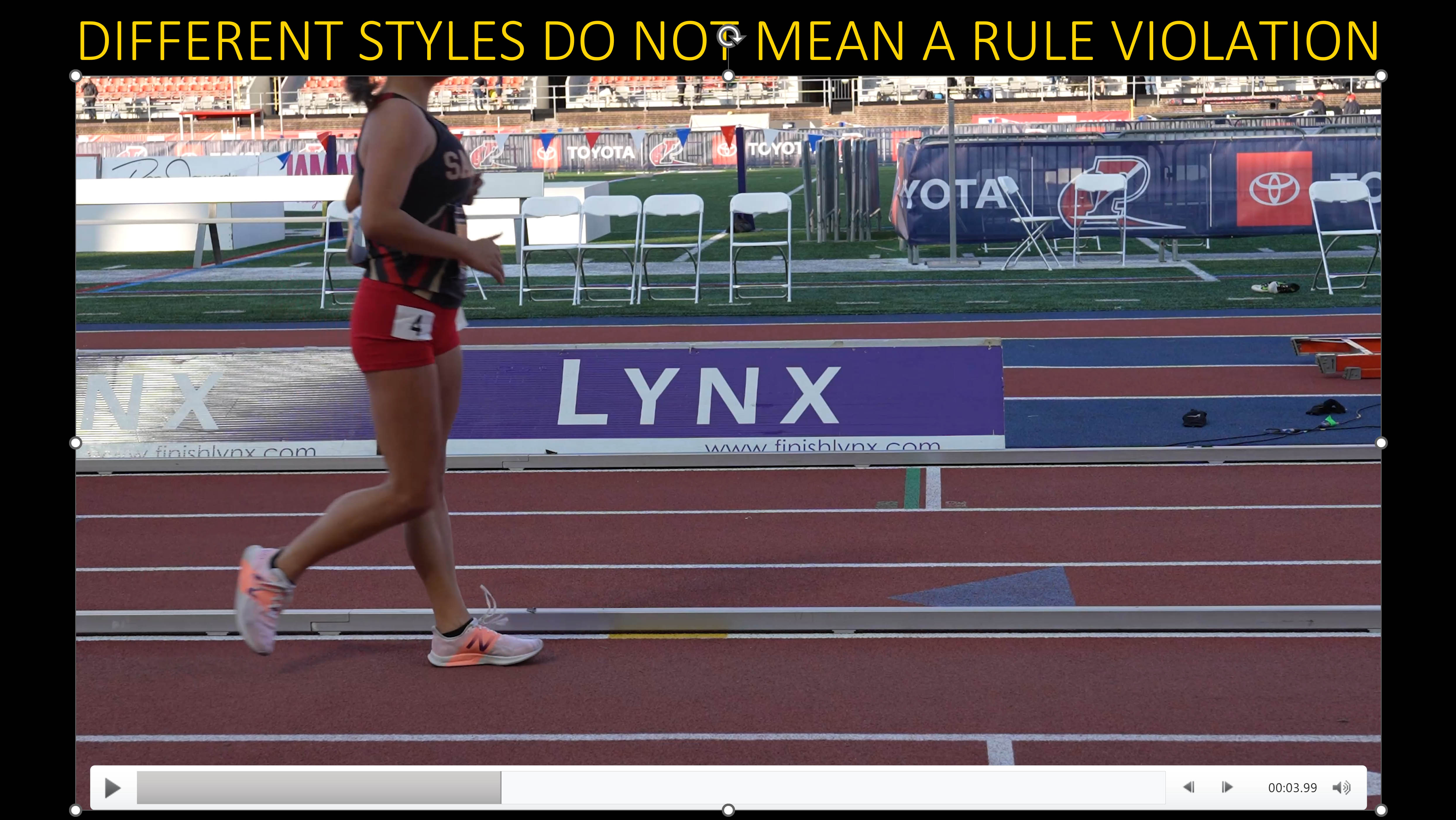
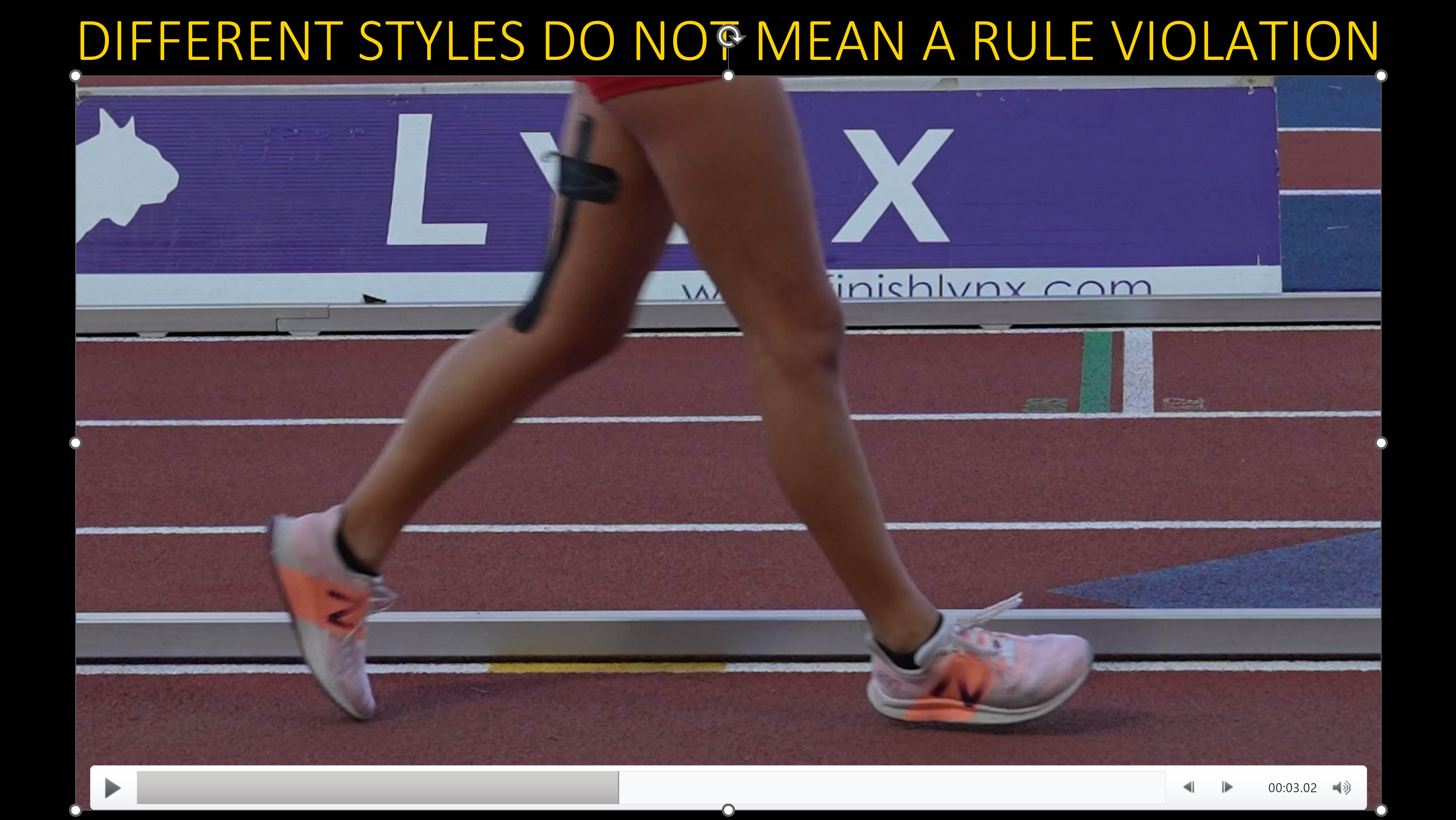
Let's look at the next walker as a close up video first. How does she look to you?
Now, let's look at her from far away. Does the bouncing hair distract you? Does it make you feel she is off the ground excessively? Perhaps her socks are distracting. A good judge does not allow these variations to affect their judging decision.
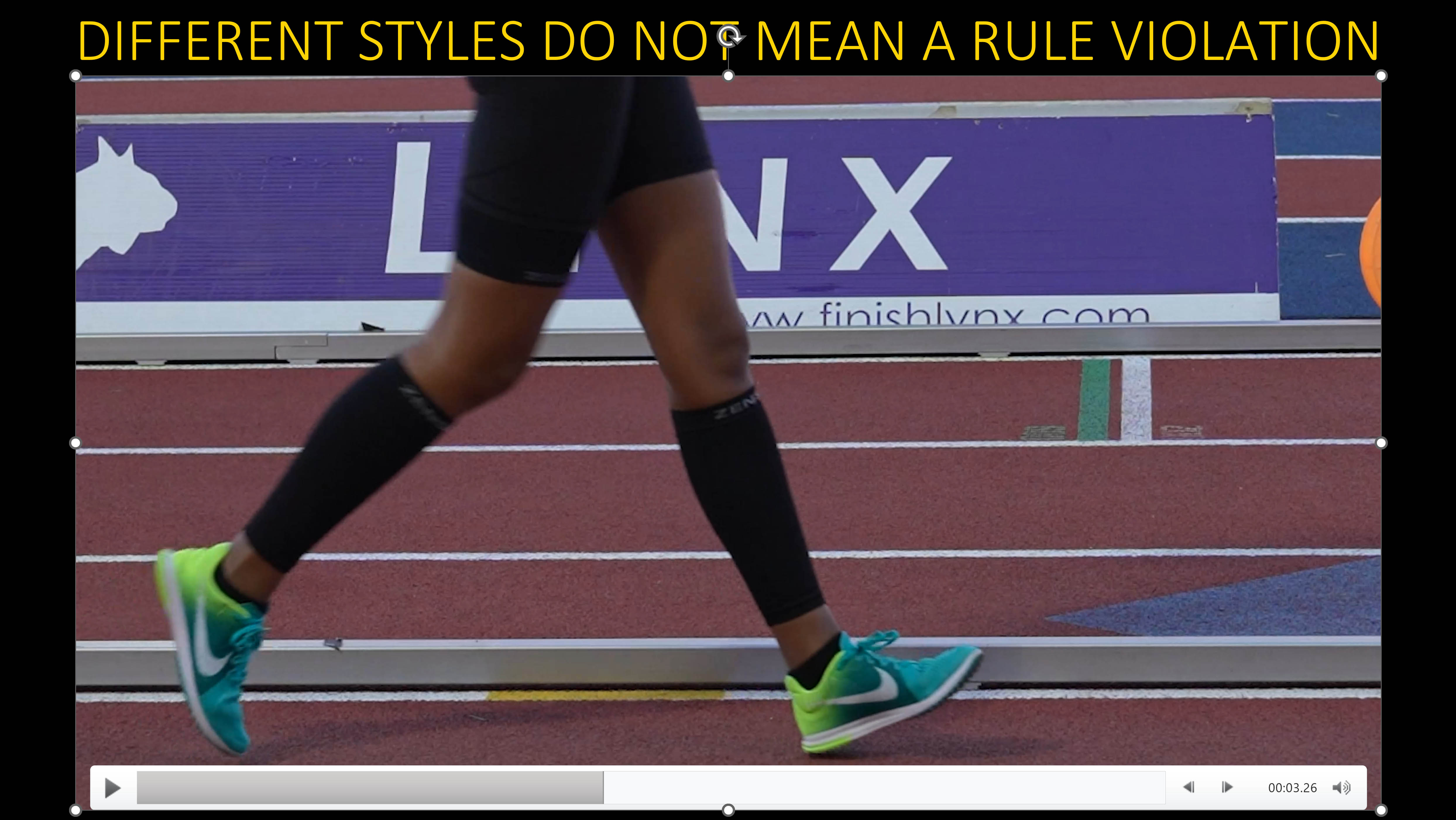
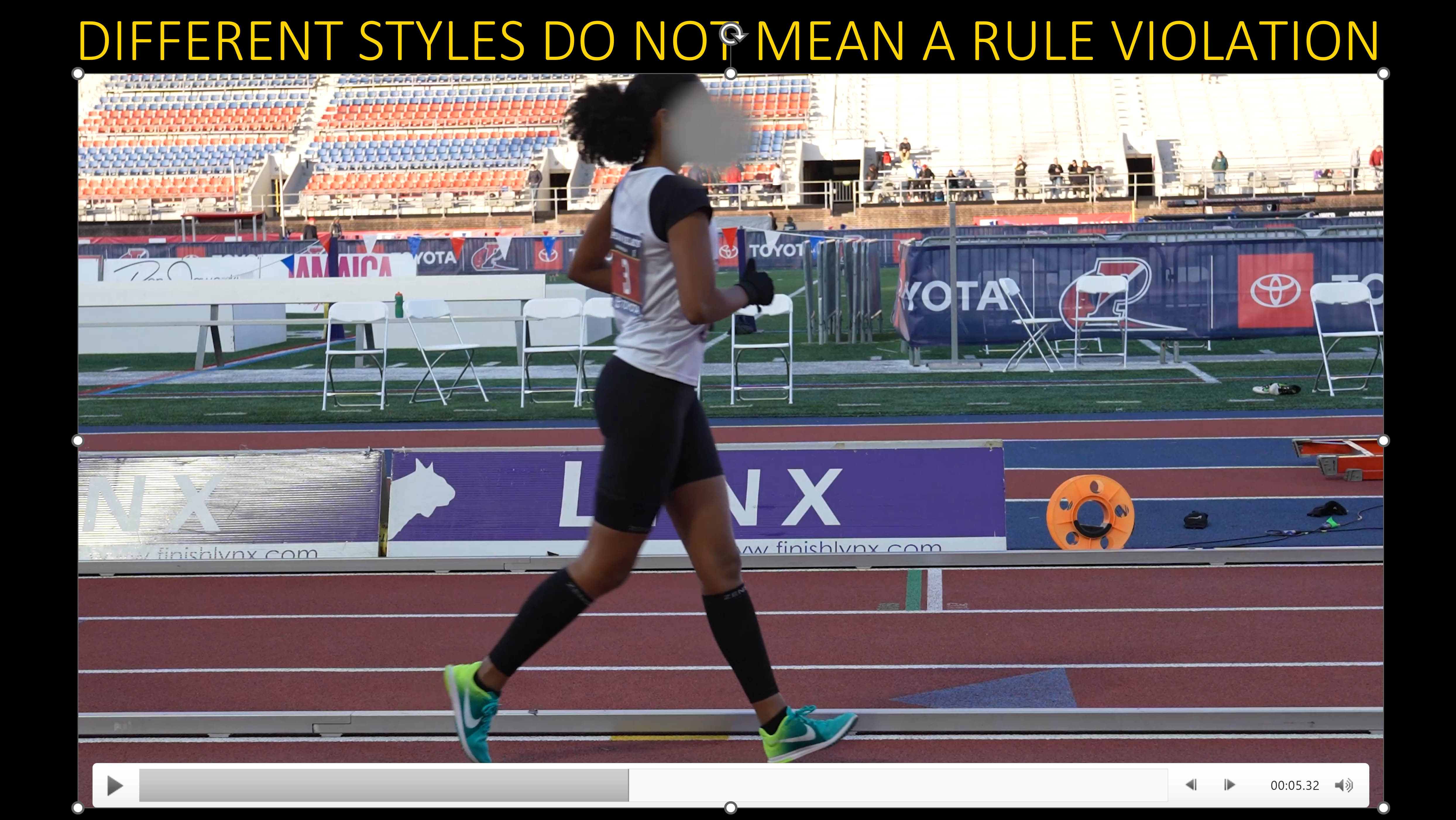
Next Lesson: Judging Tools